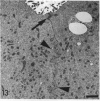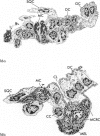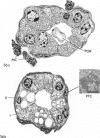Abstract
The harderian gland was first described in 1694 by Johann Jacob Harder (1656-1711). It occurs in most terrestrial vertebrates and is located within the orbit where, in some species, it is the largest structure. It may be compound tubular or compound tubuloalveolar, and its secretory duct is usually morphologically distinct only after leaving the substance of the gland to open on the surface of the nictitating membrane. The tubules of the gland are formed of a single layer of columnar epithelial cells surrounded by myoepithelial cells. The chief product(s) of the gland varies between different groups of vertebrates, and epithelial cells possess granules or vacuoles whose contents may be mucous, serous or lipid. In rodents, the gland synthesises lipids, porphyrins and indoles. In the case of lipid vacuoles, the gland is unusual in releasing these by an exocytotic mechanism. It is unclear whether the gland can act both as an exocrine and endocrine organ. There is control of gland structure and synthesis through a variety of humoral agents, including gonadal, thyroid and pituitary hormones; in addition there is a rich autonomic innervation and many neuropeptides have been identified. The proposed functions of the gland are remarkably diverse and include the gland being (1) a source of 'saliva', (2) a site of immune response, (3) a photoprotective organ, (4) part of a retinal-pineal axis, (5) a source of pheromones, (6) a source of thermoregulatory lipids, (7) a site of osmoregulation, and (8) a source of growth factors. The gland is discussed in terms of its embryology and phylogeny, and in relation to ecological variables. Several goals of future research are identified.
Full text
PDF

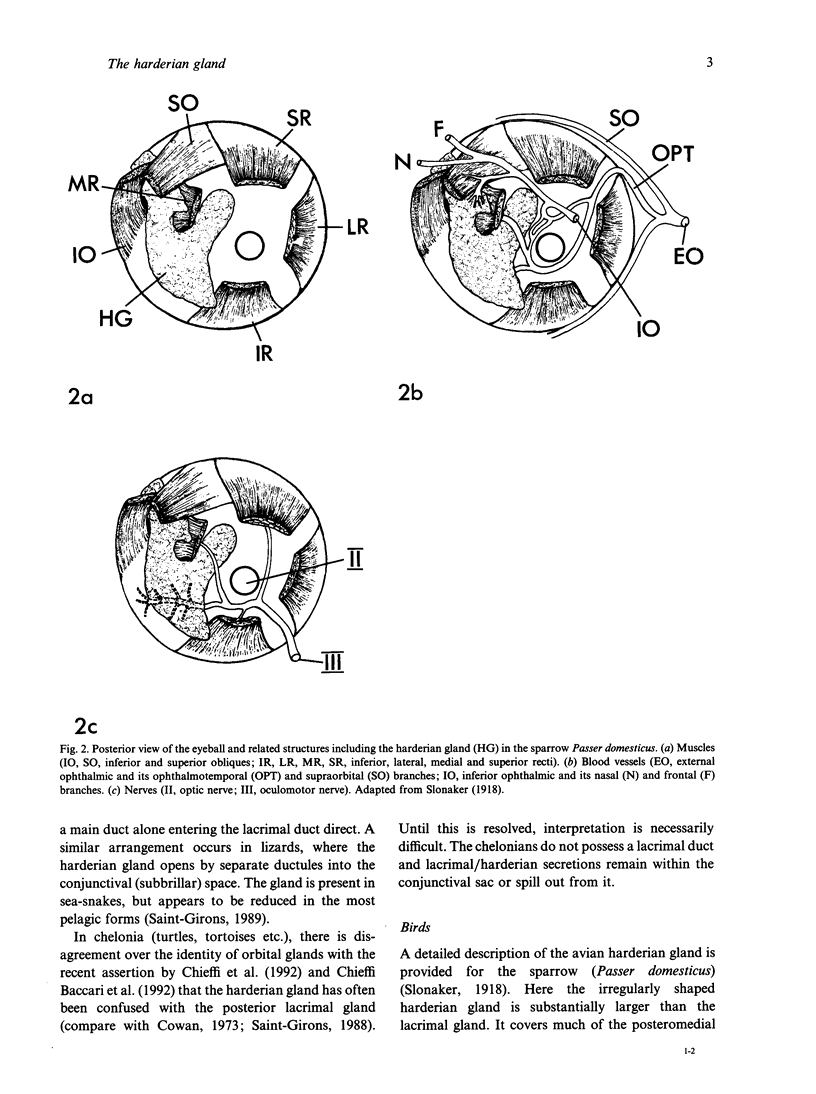
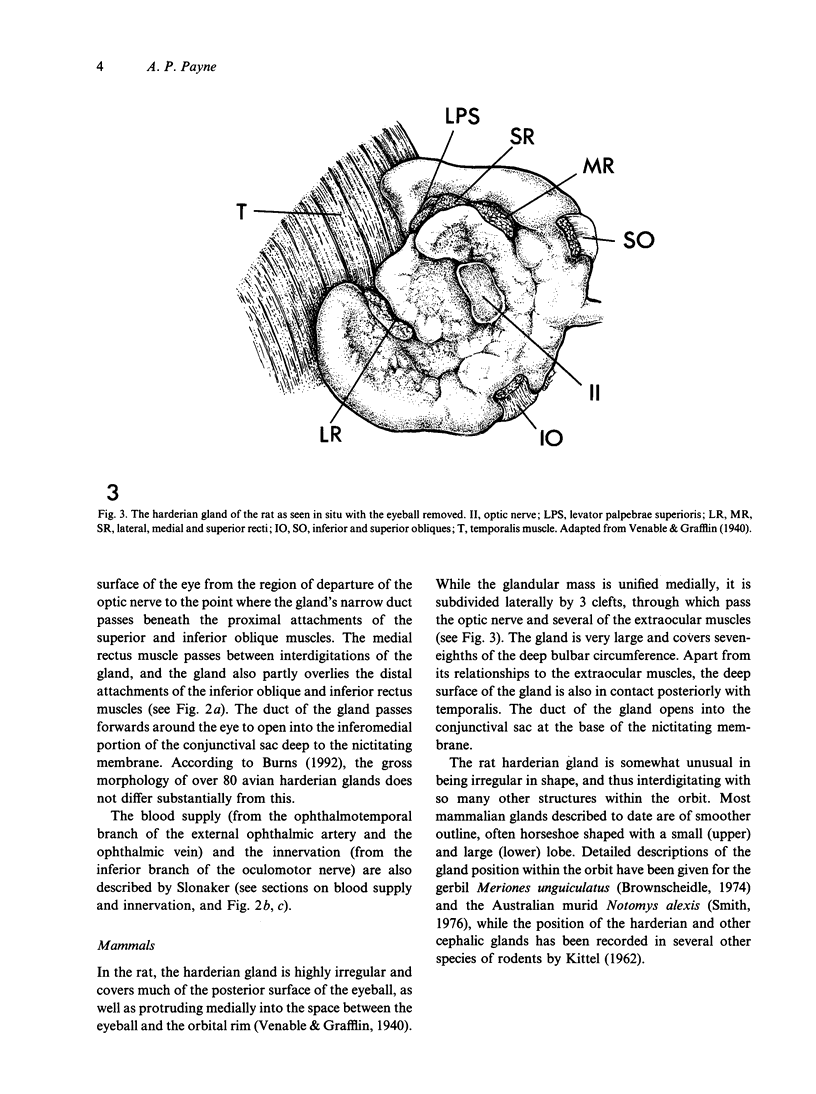
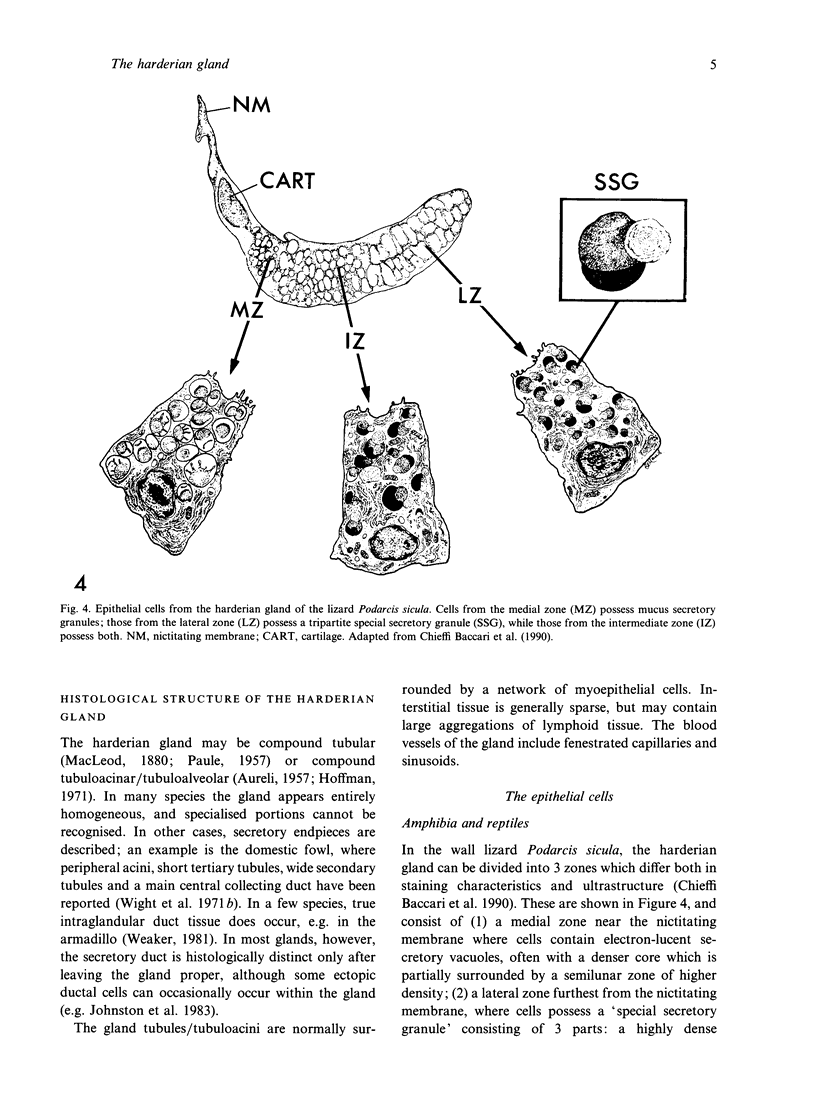
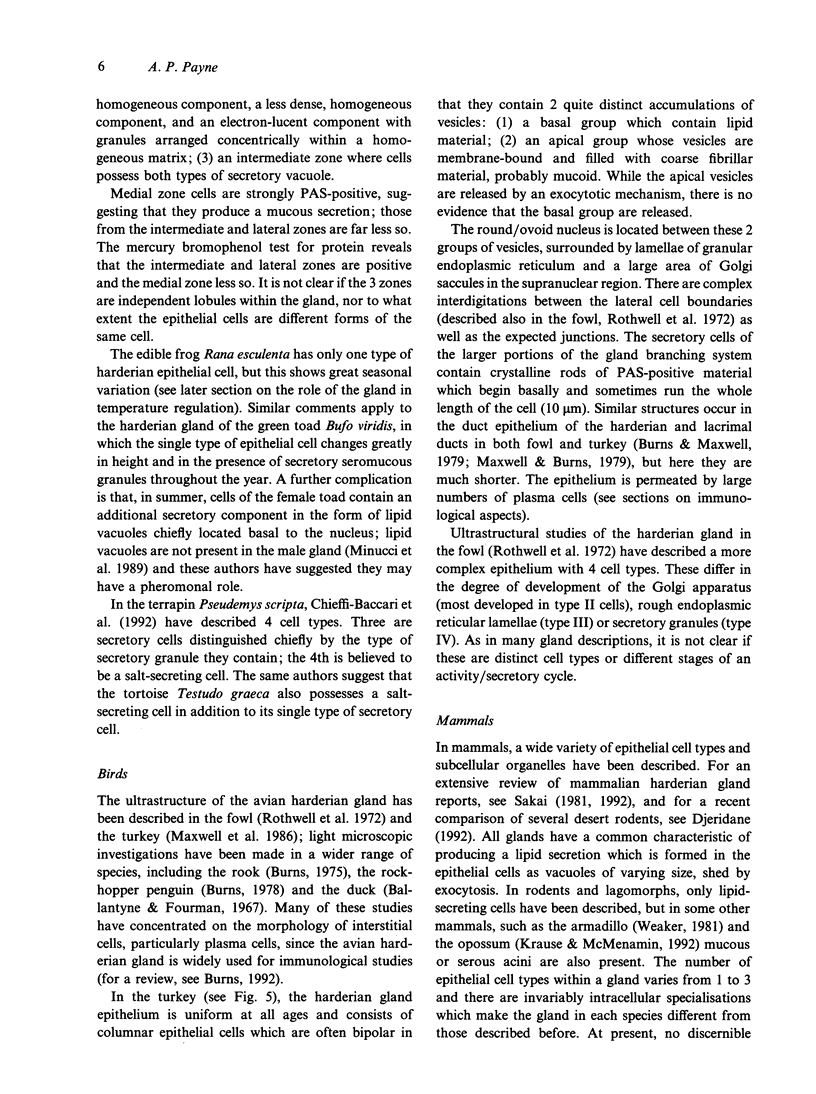

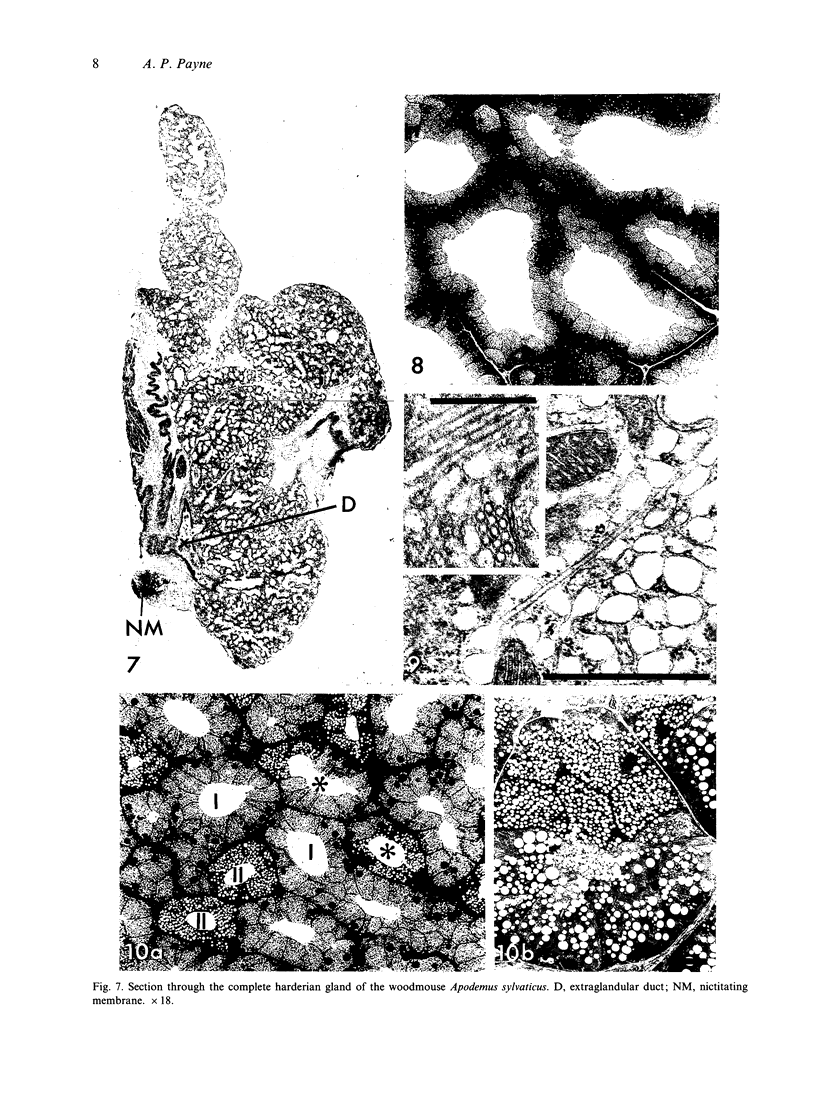
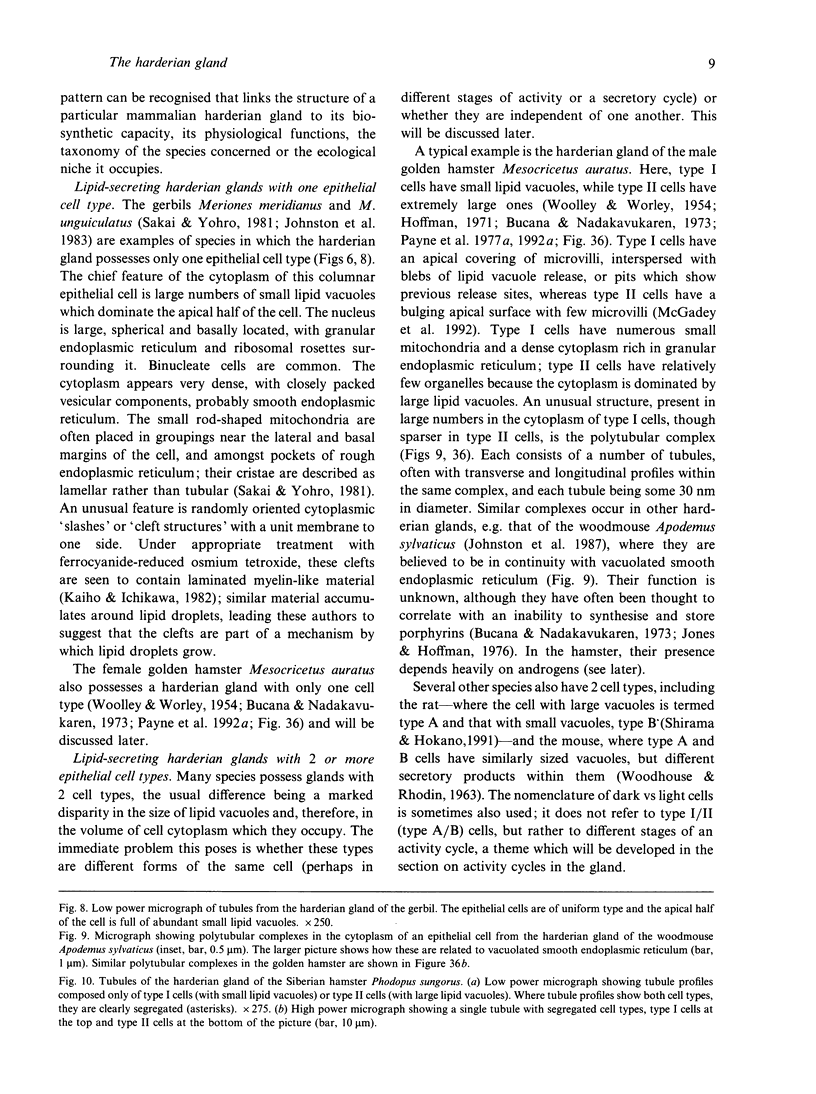

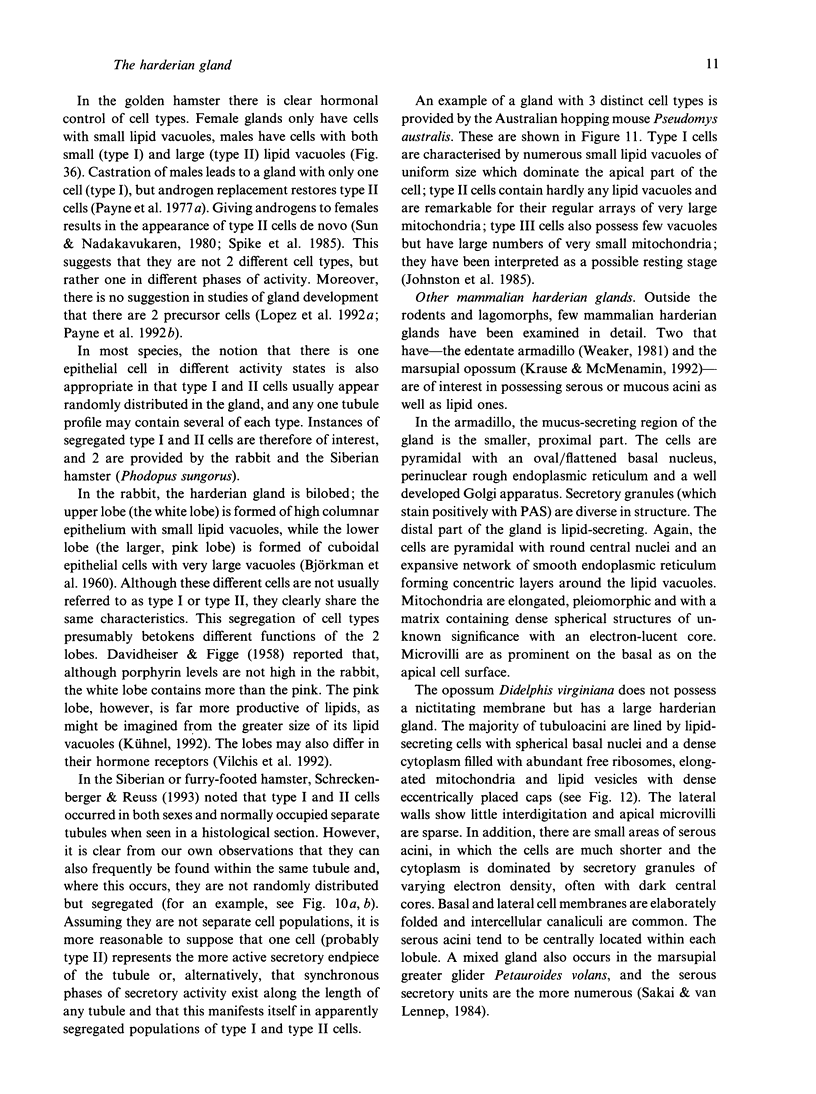
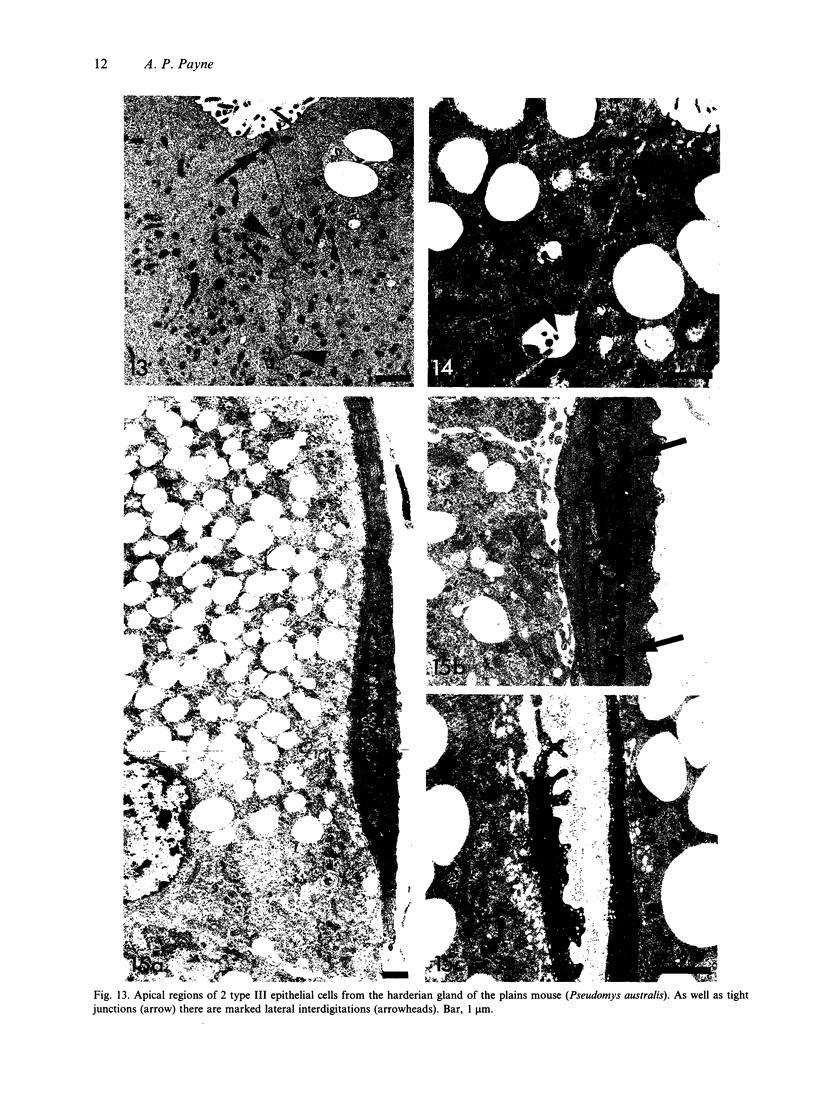
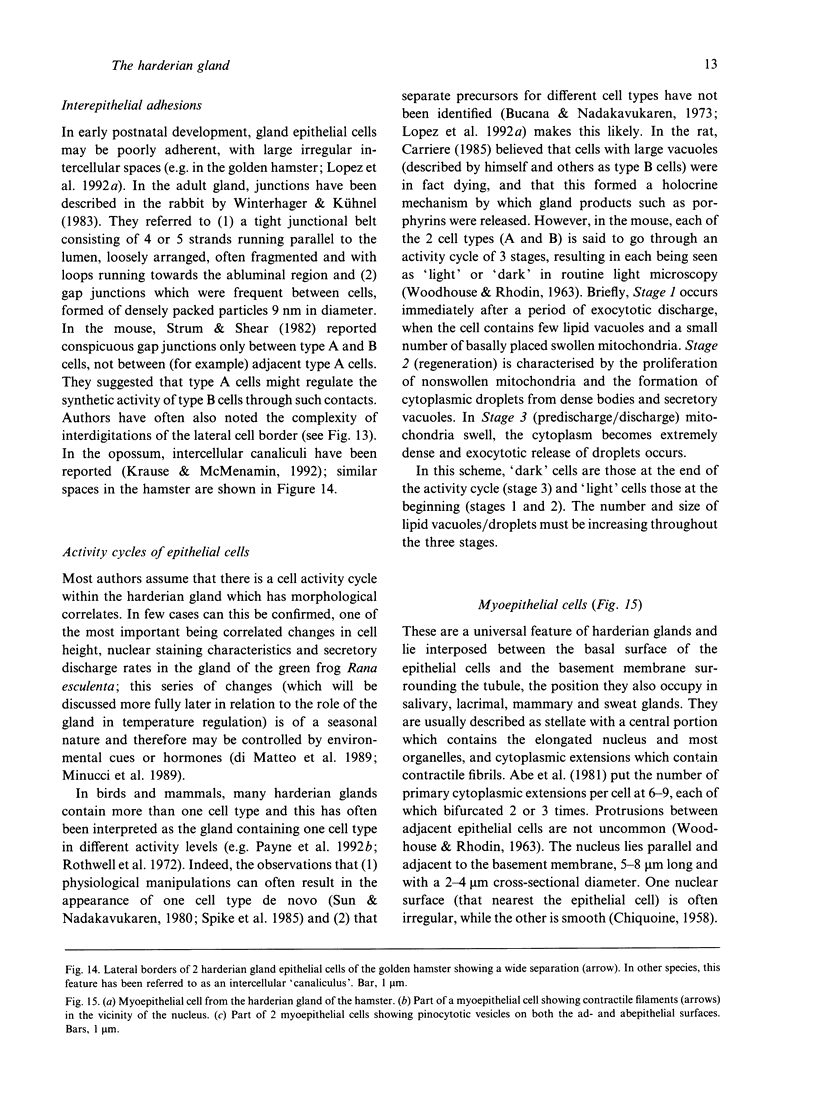
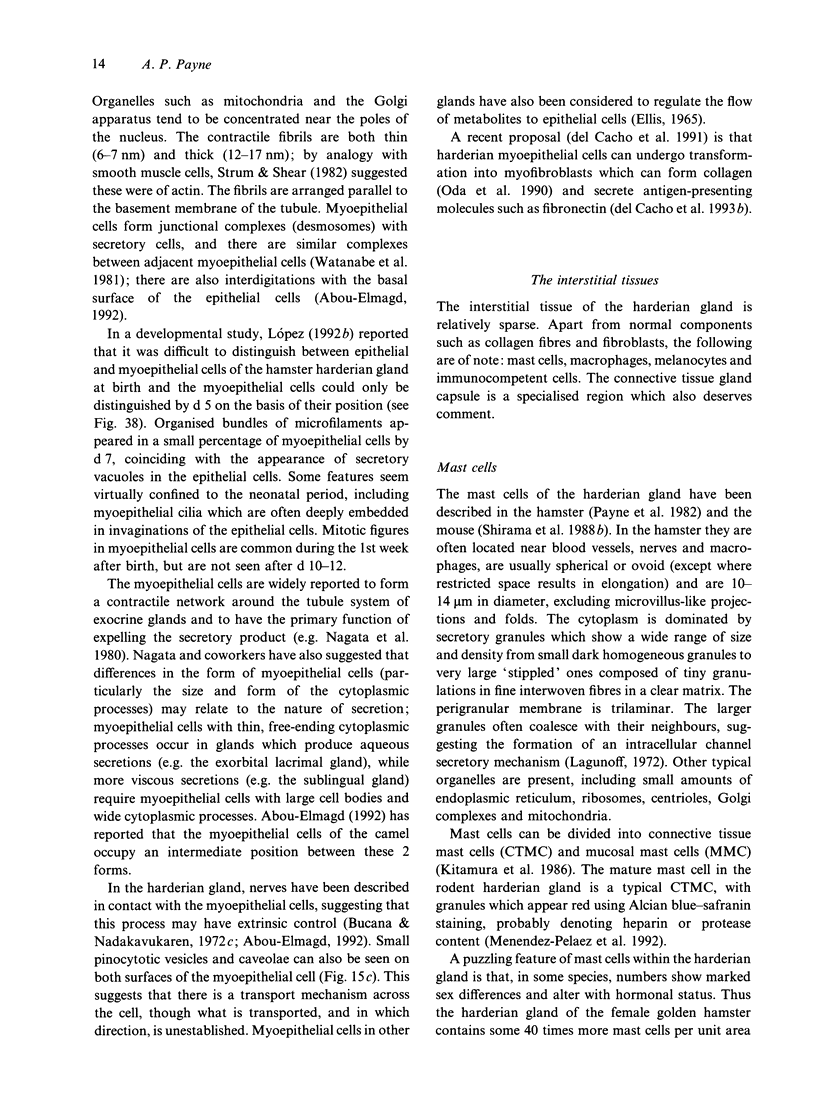
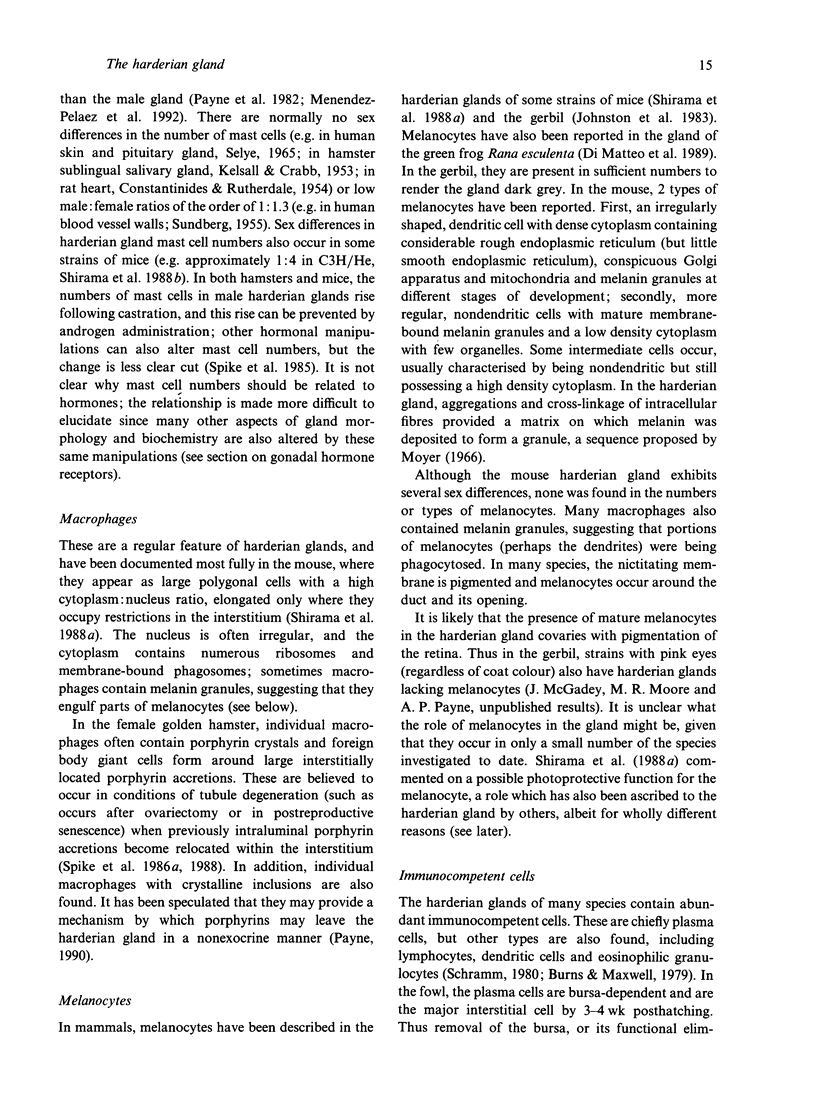
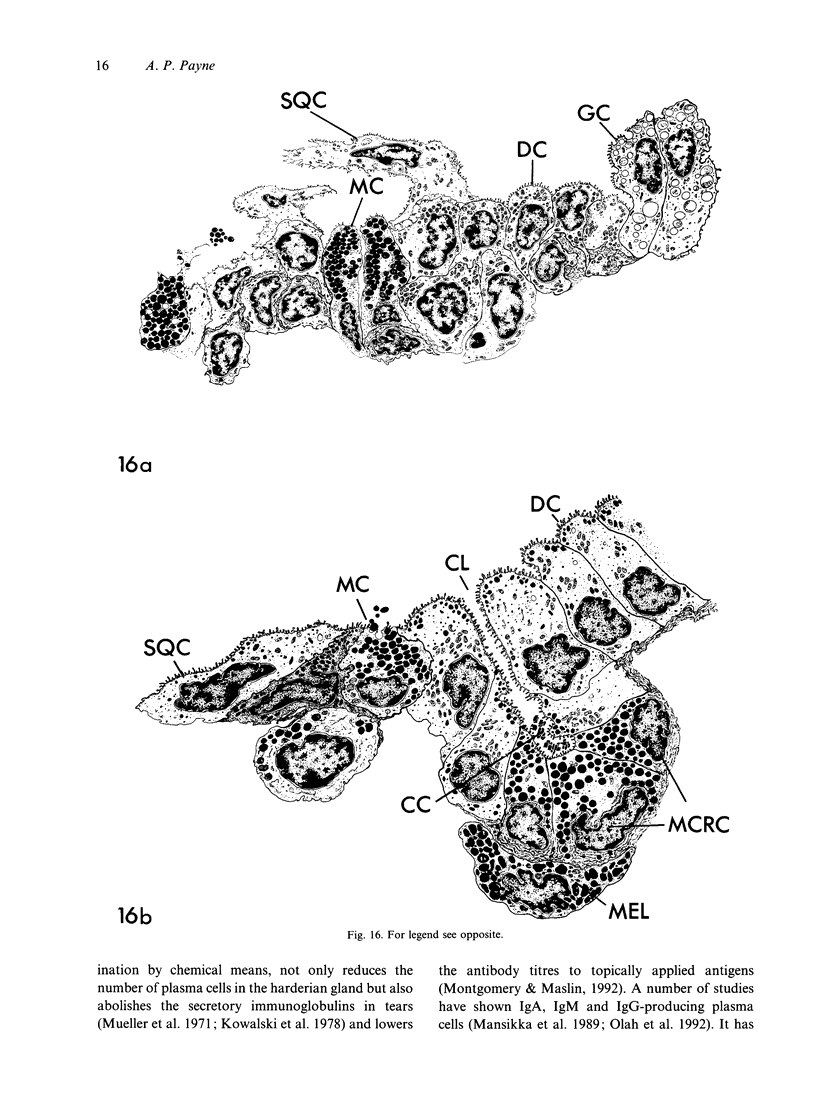

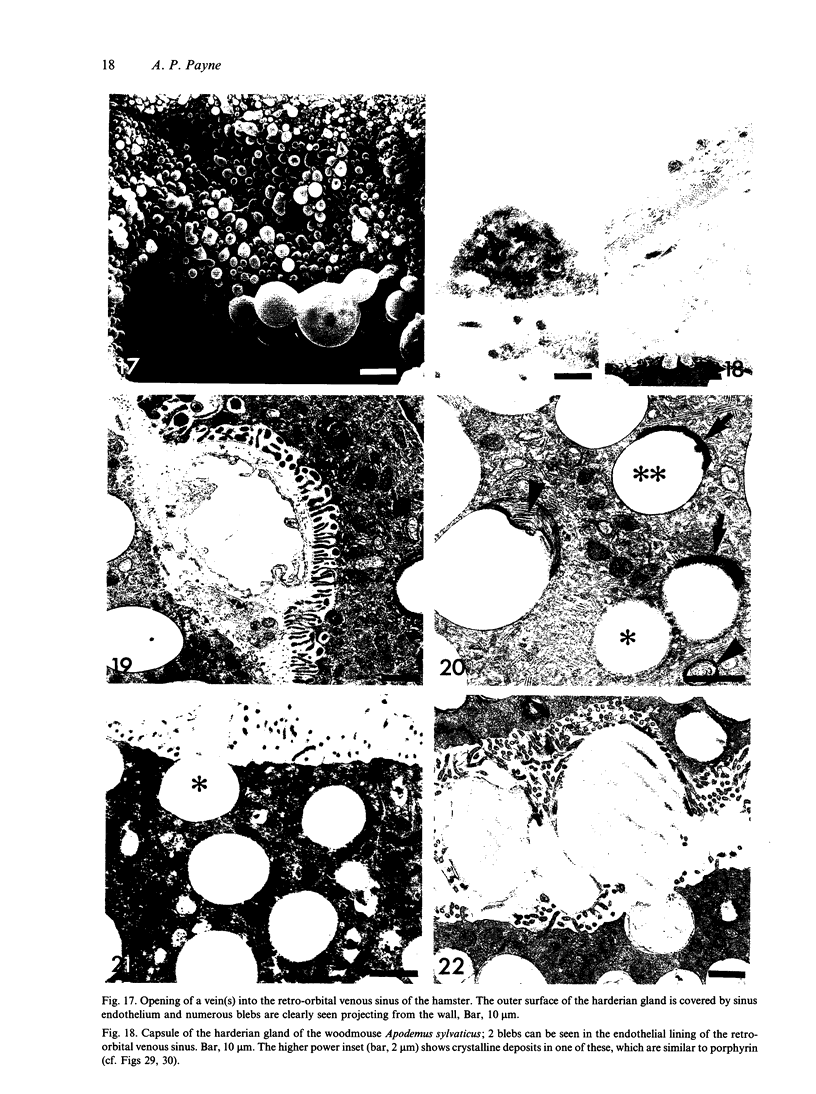
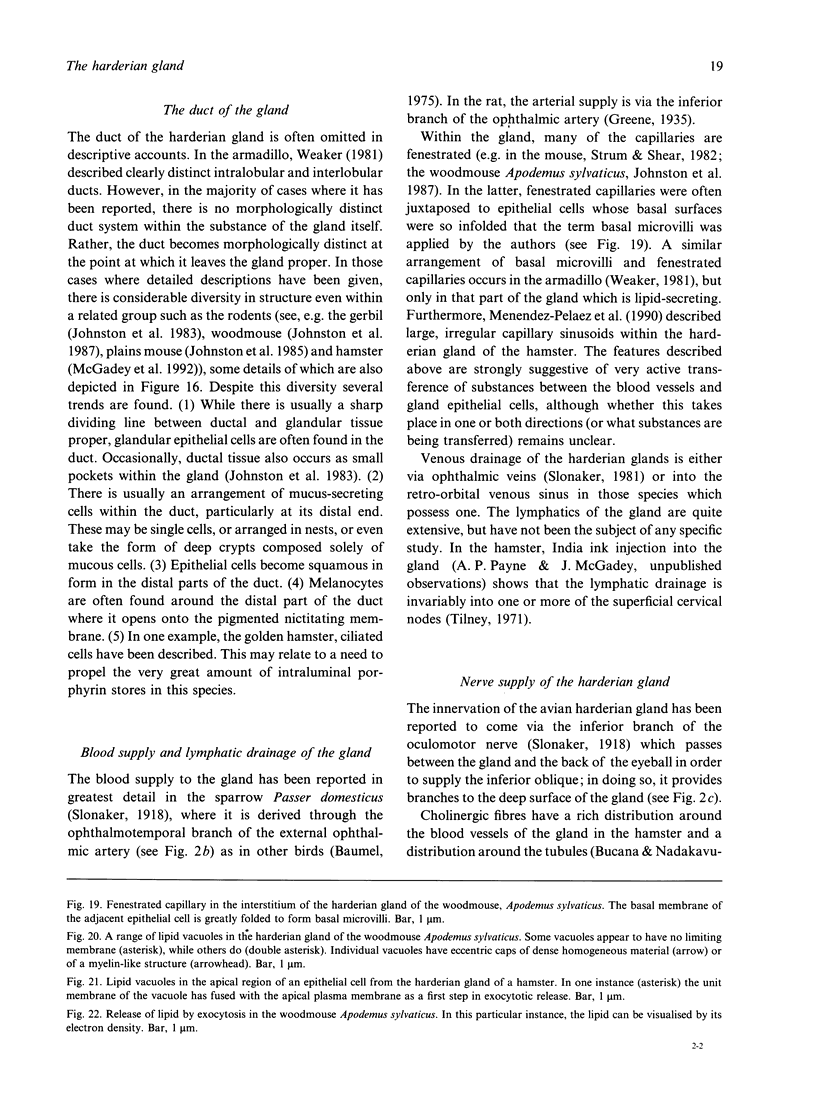
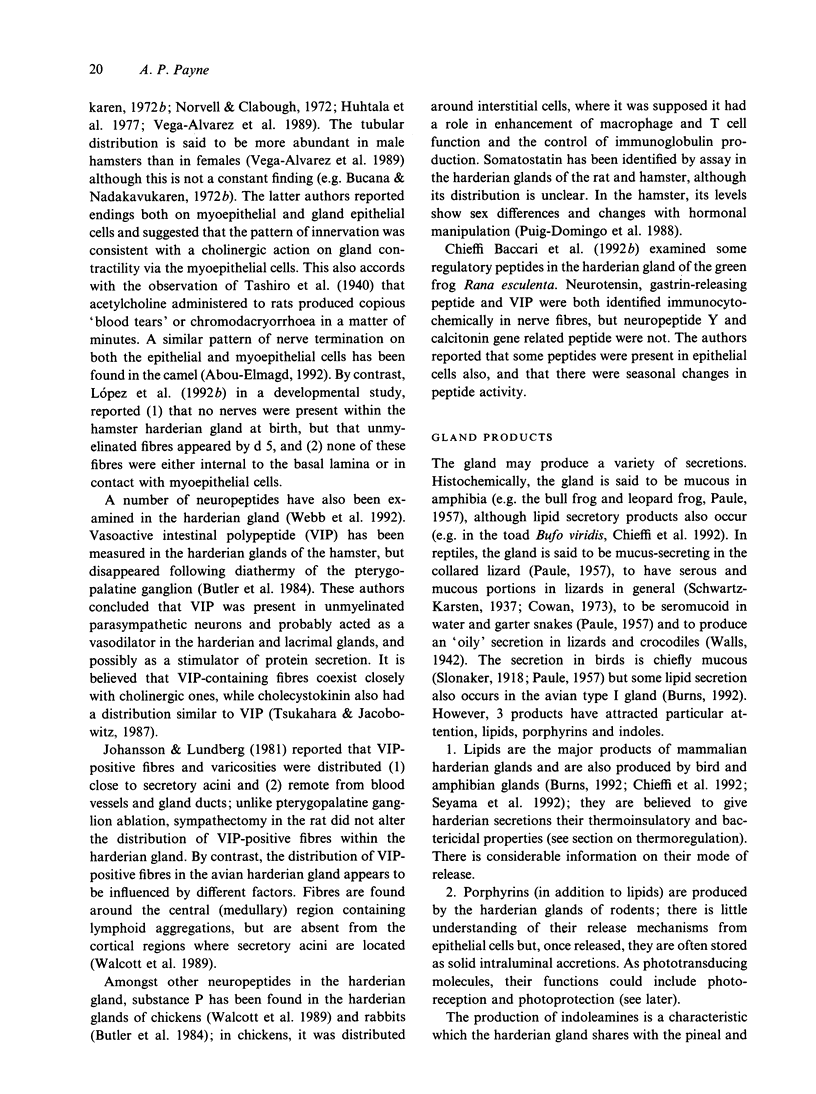
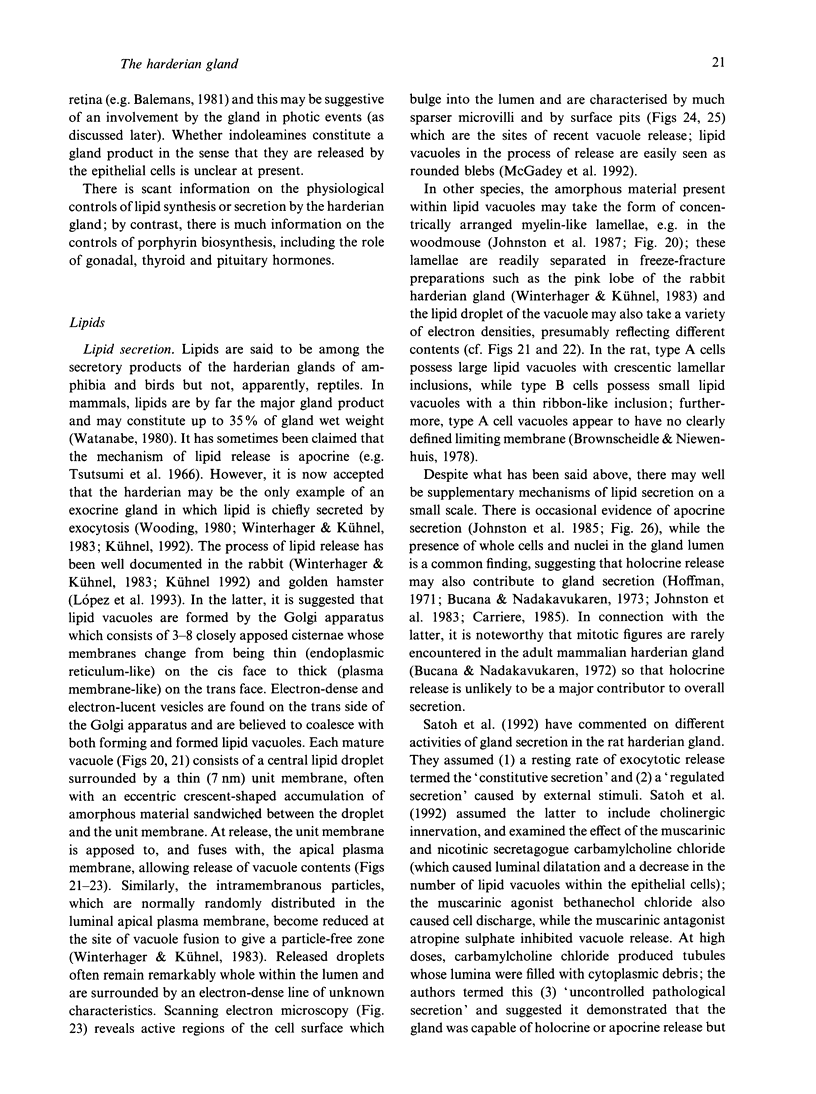

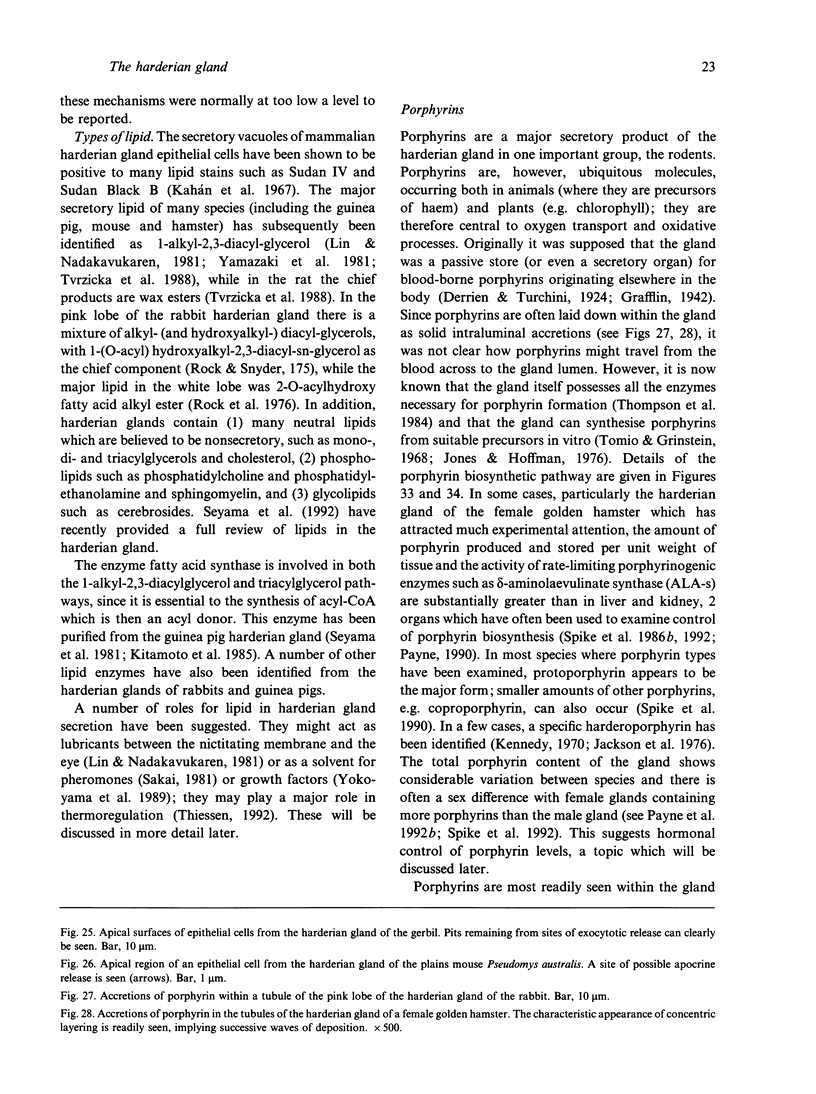
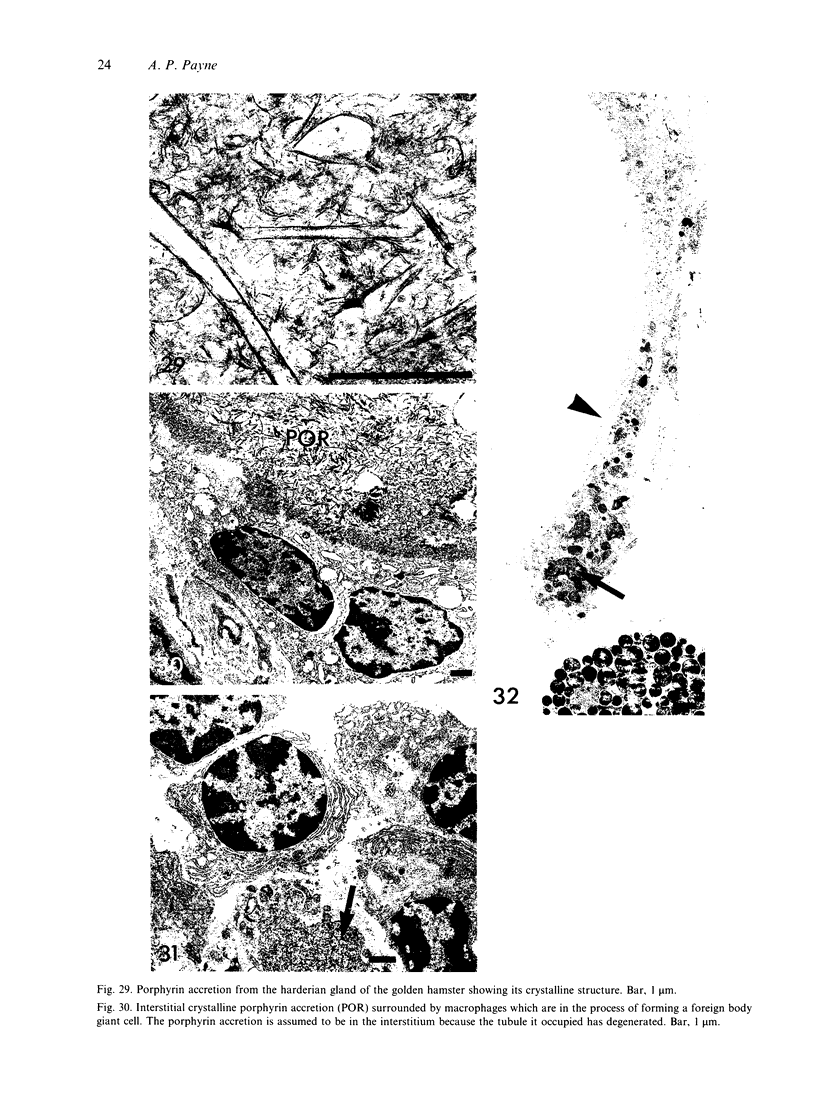

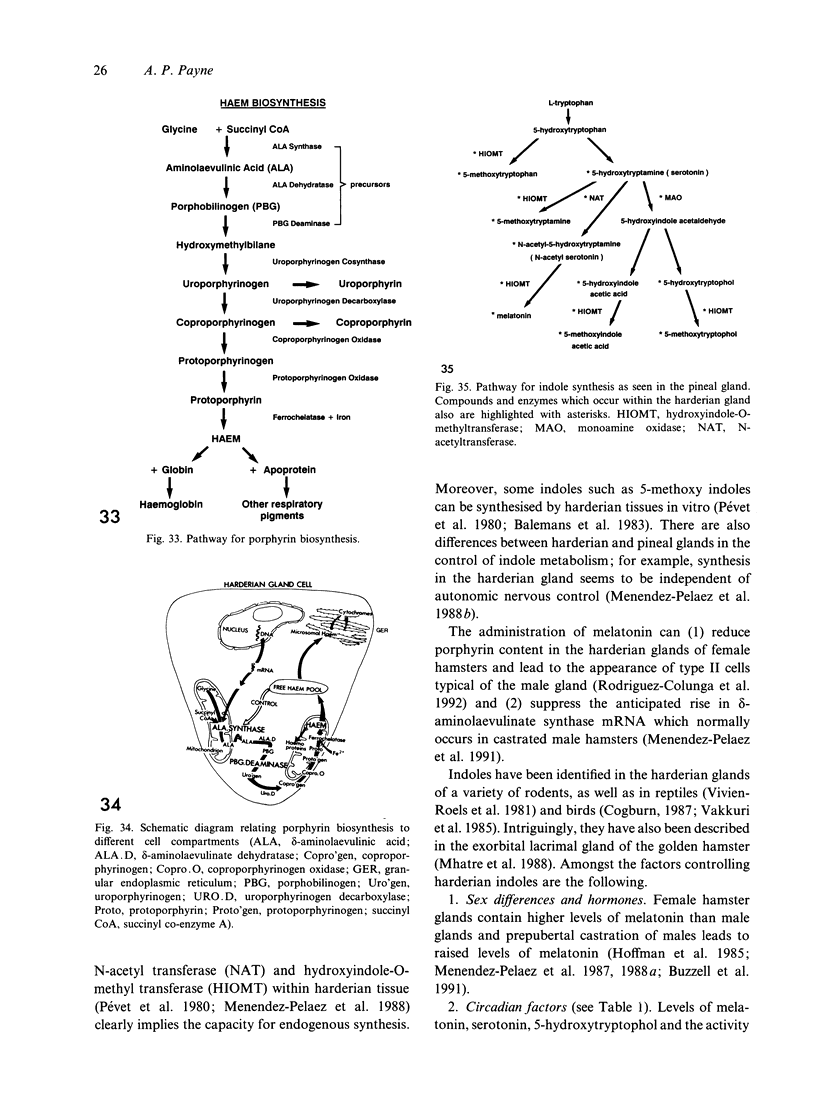
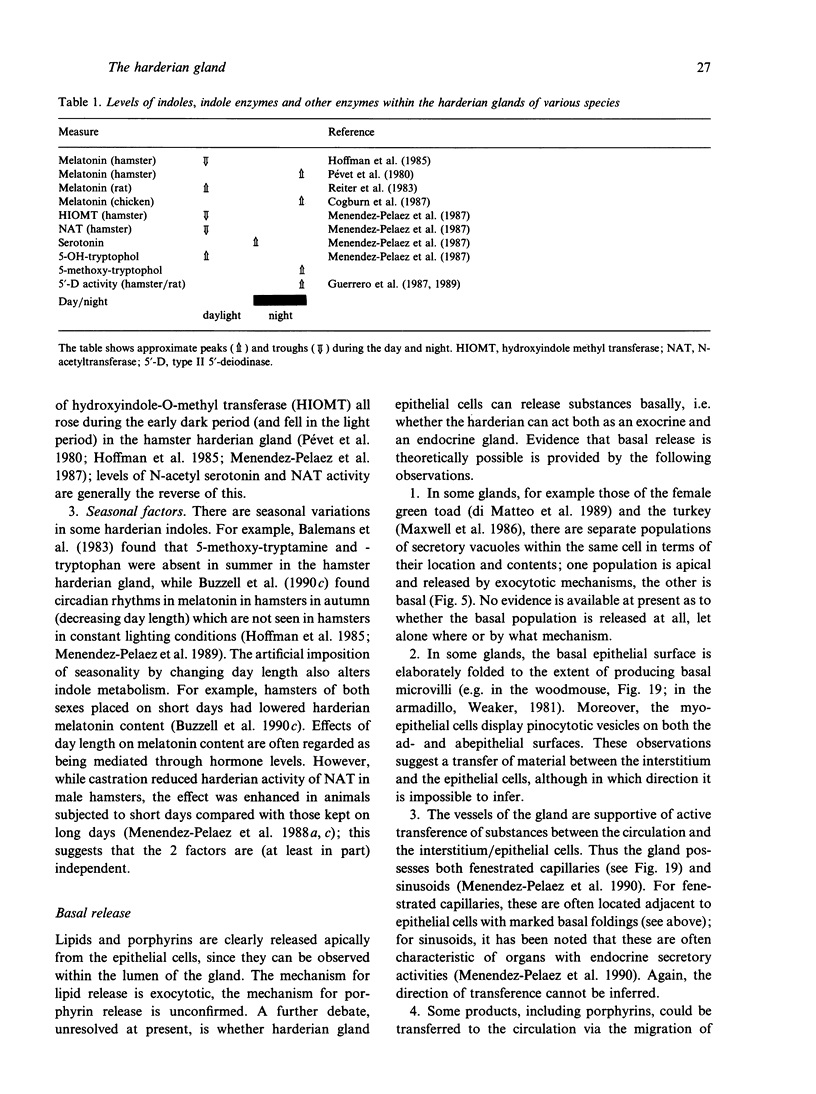
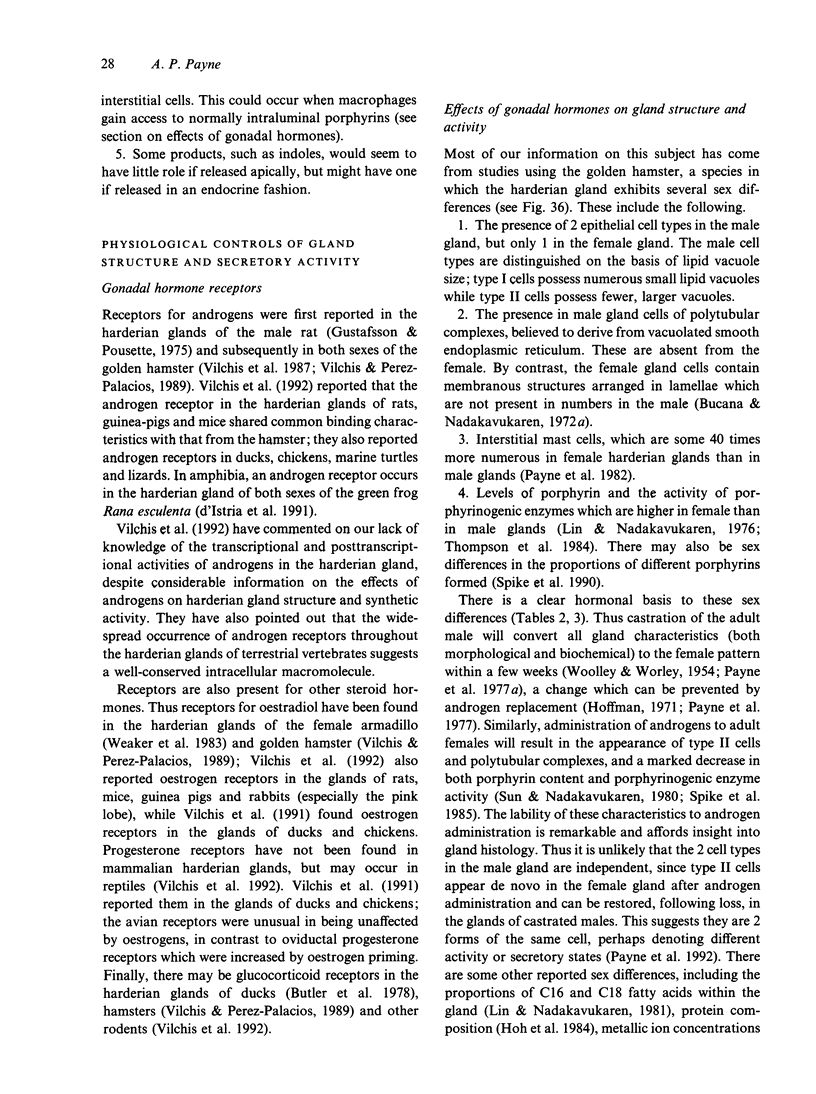
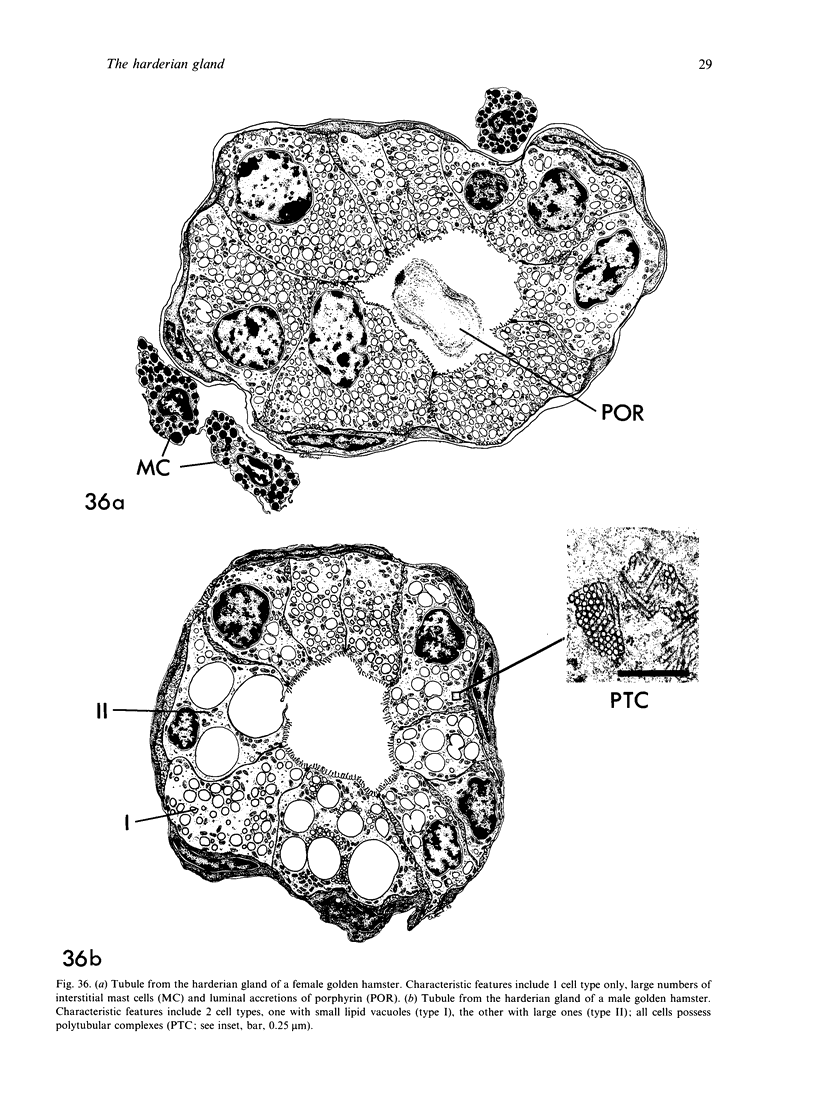
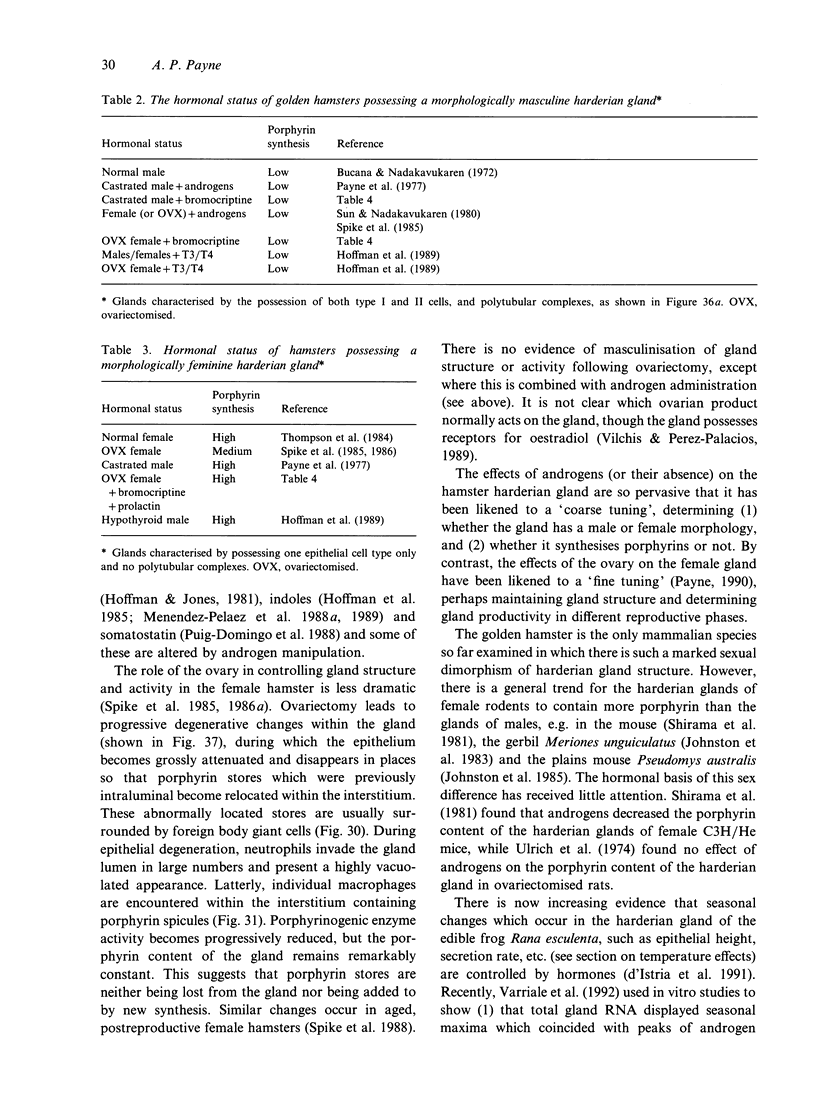
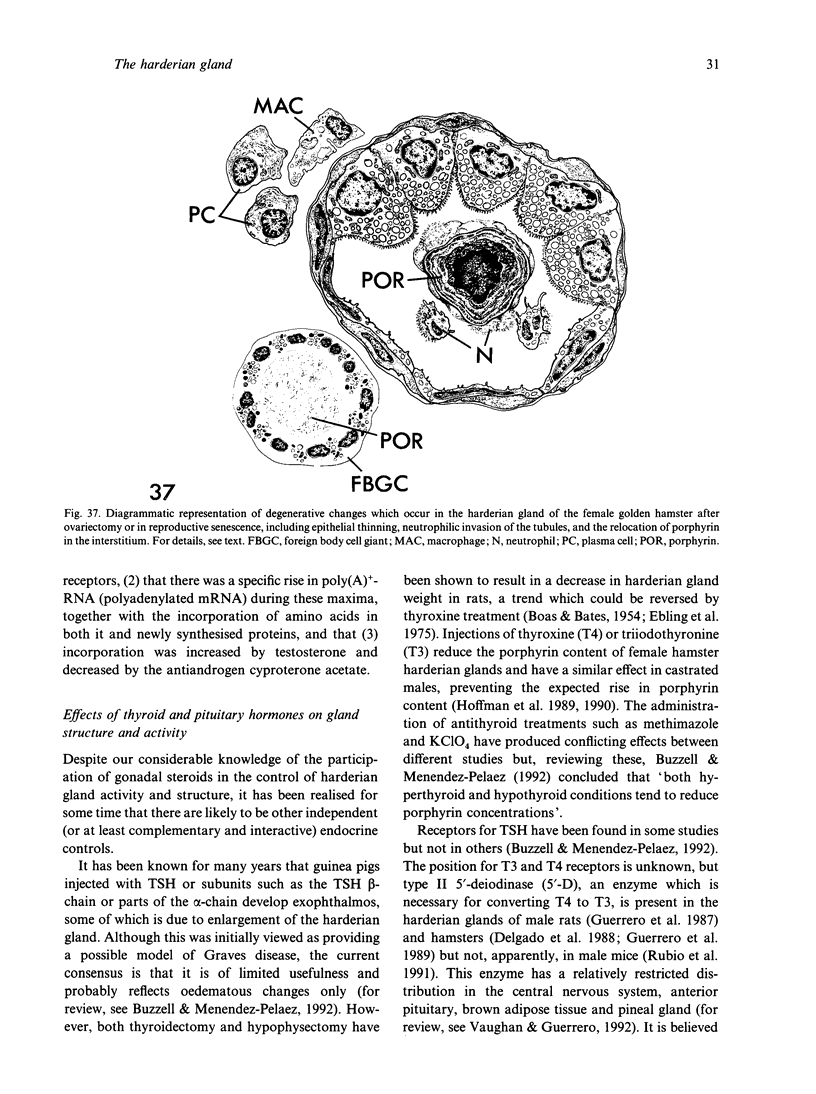
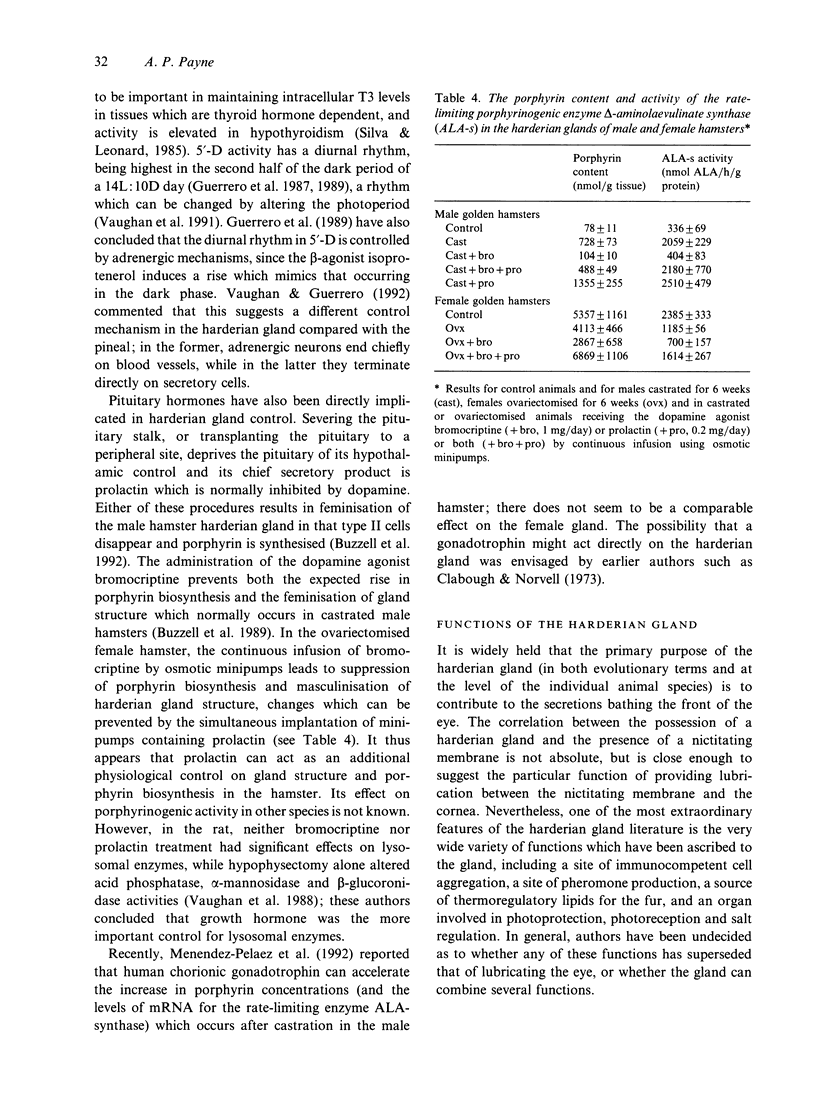

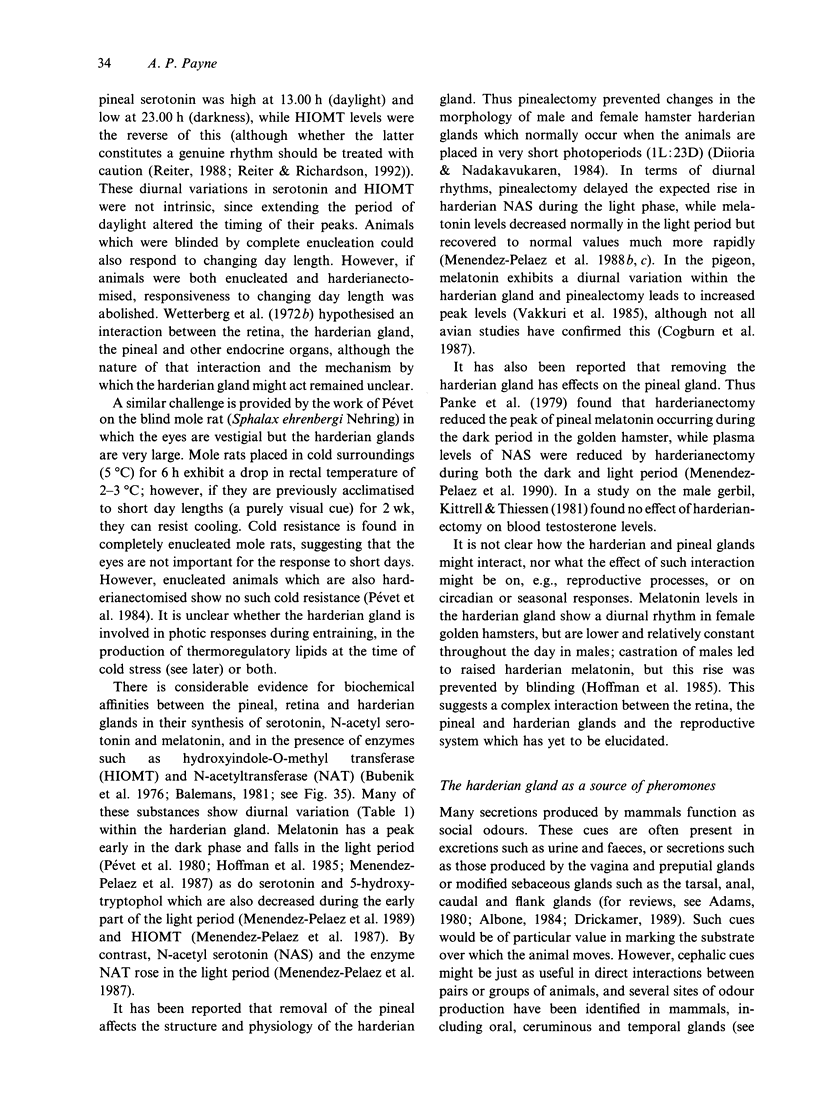
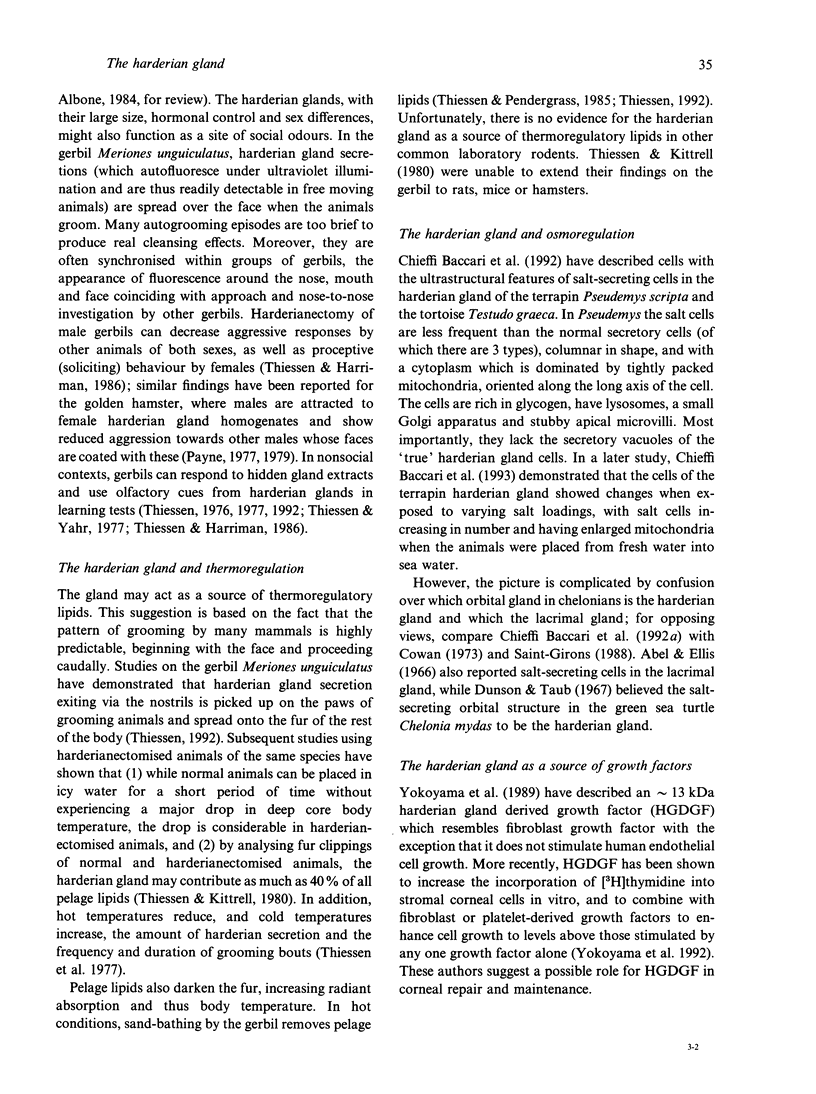




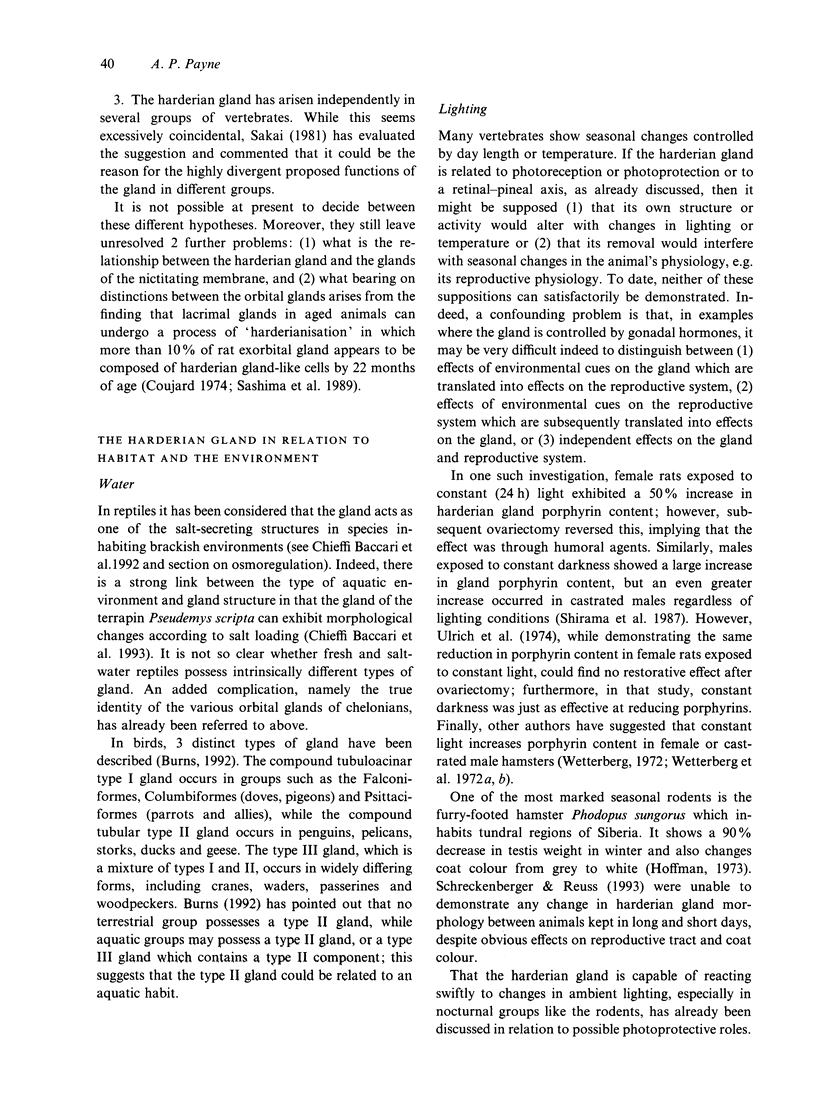
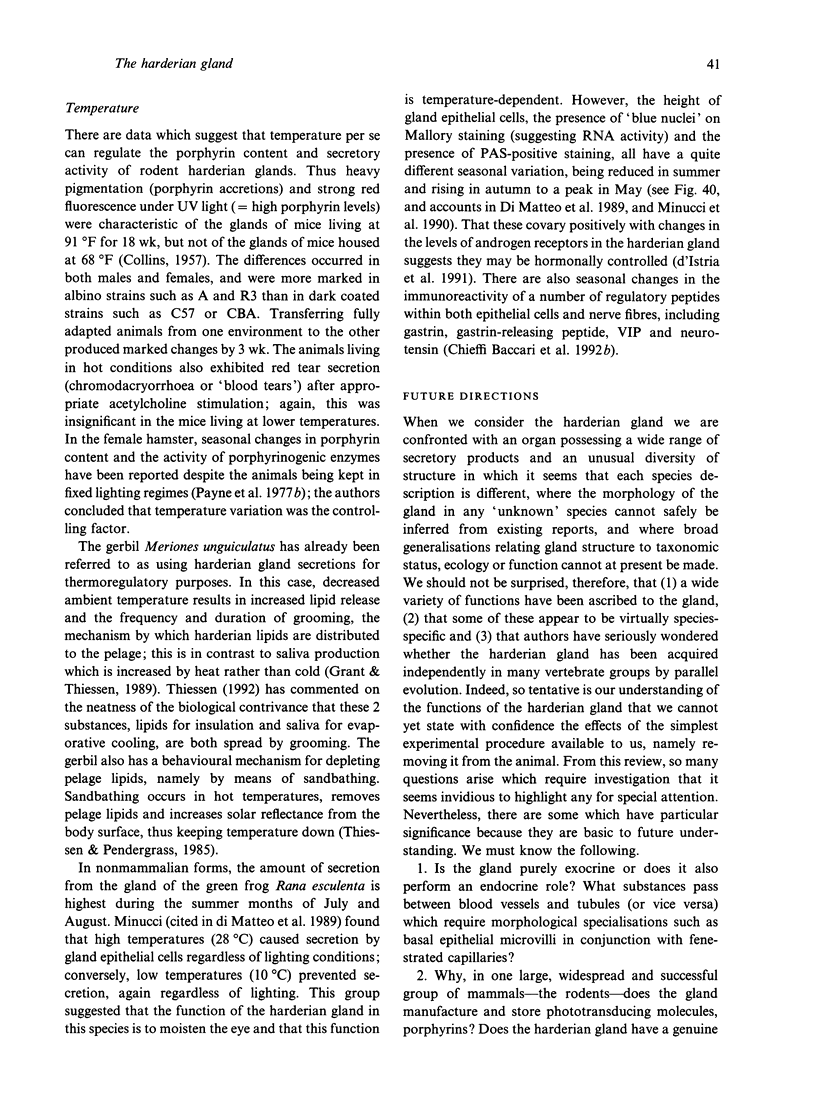

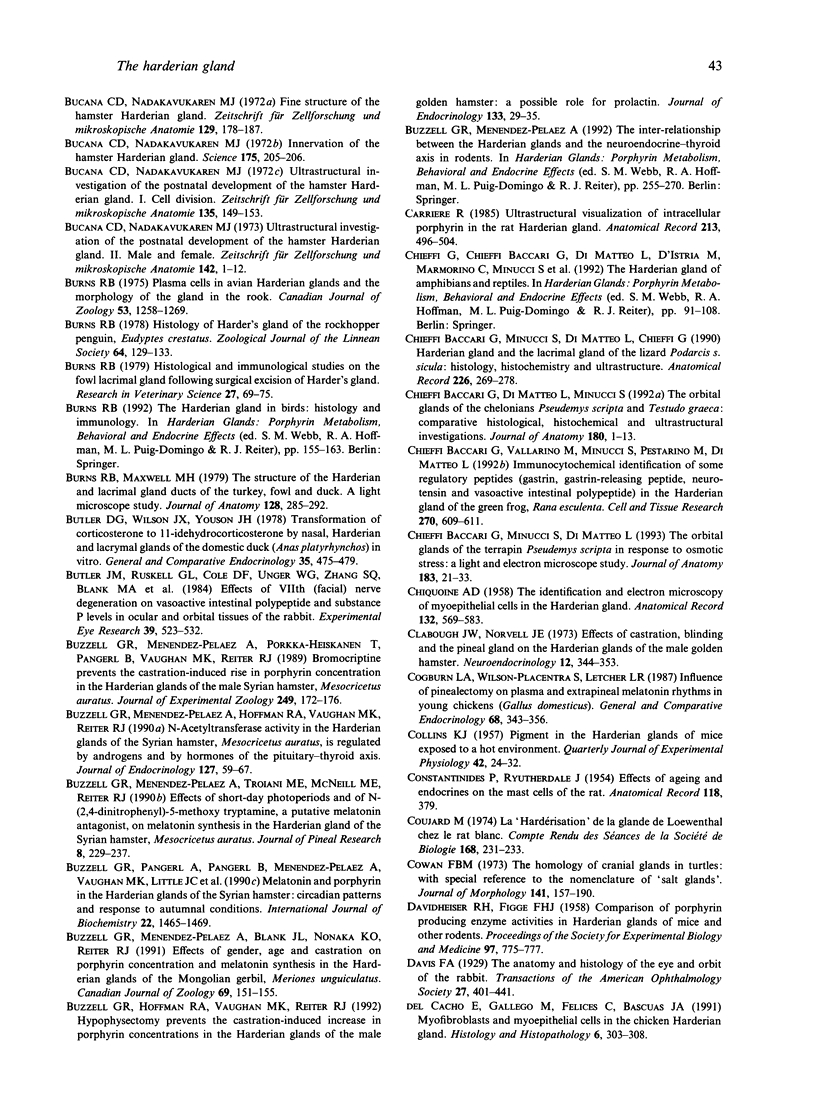


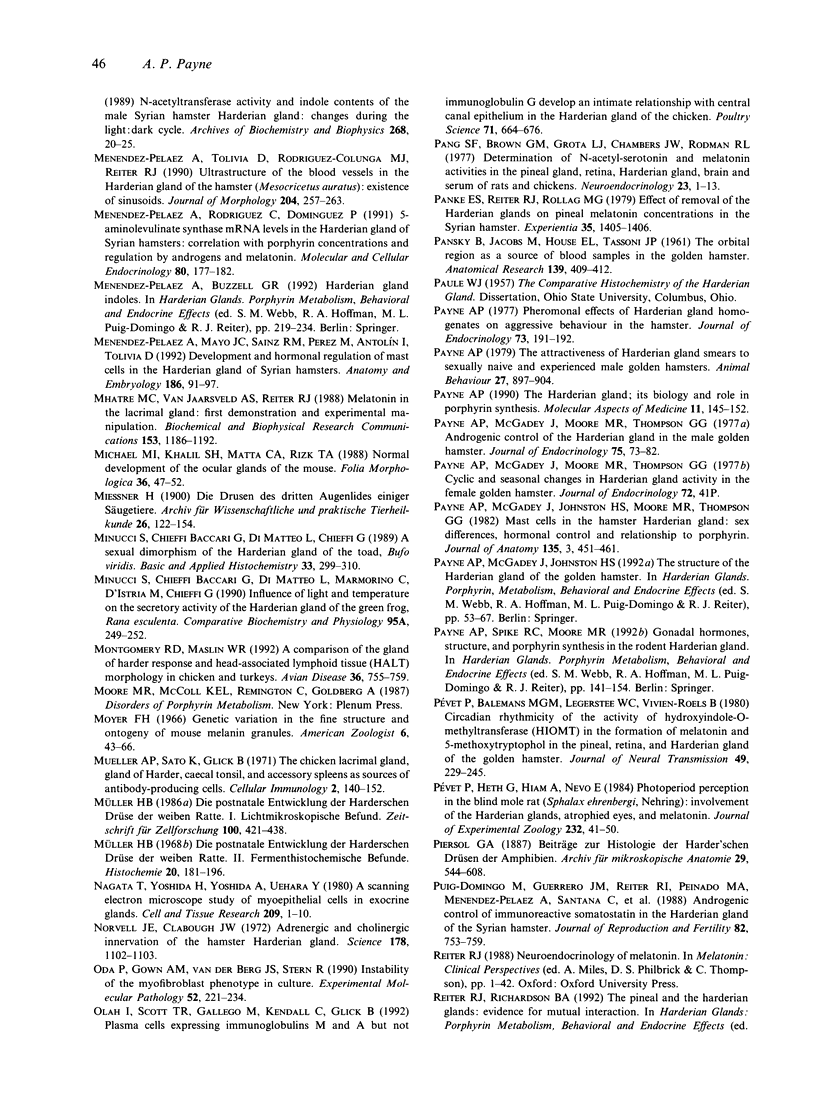

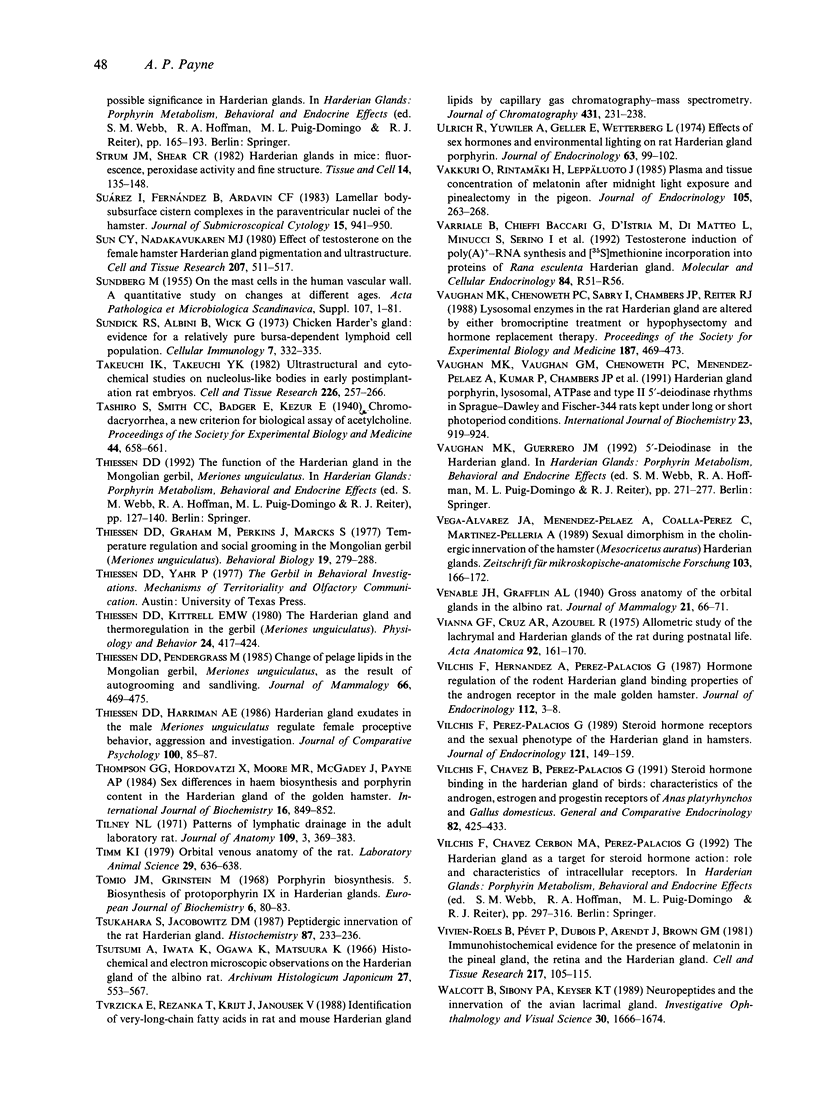
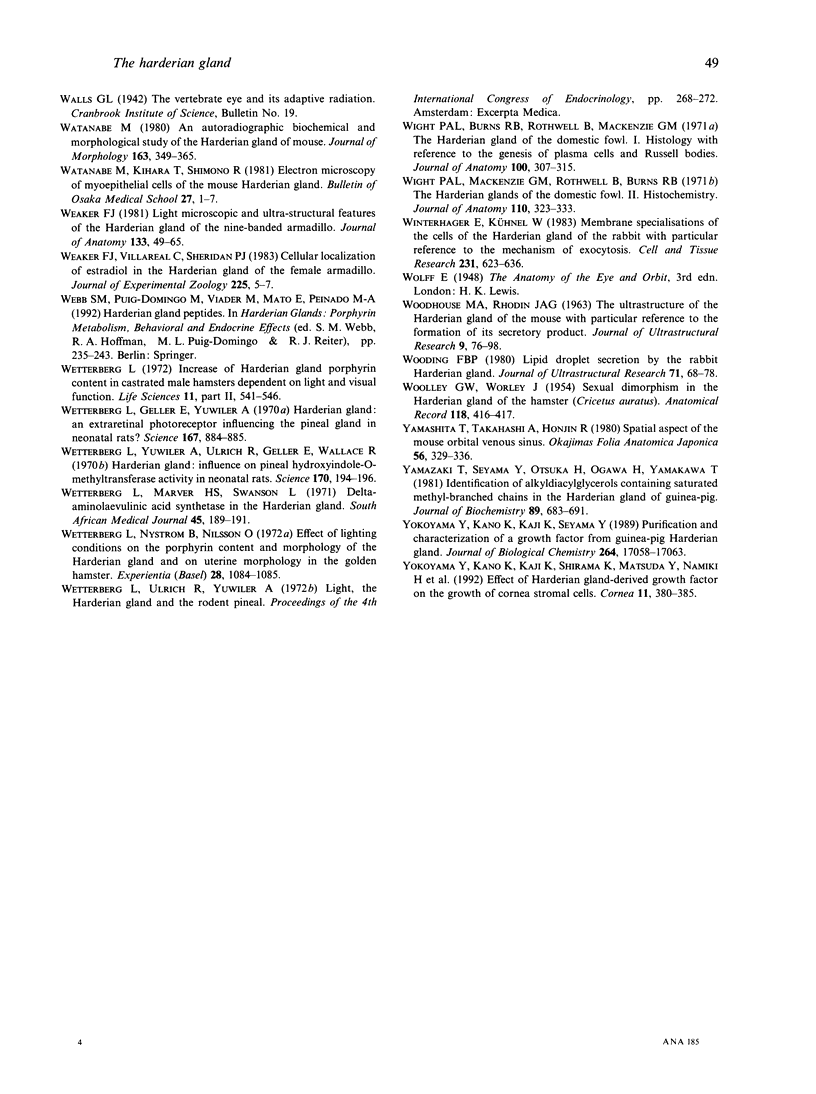
Images in this article
Selected References
These references are in PubMed. This may not be the complete list of references from this article.
- Abe J., Sugita A., Hamasaki M., Nakamura K., Iwanaga S., Nagae K., Atsuji K., Tsunawaki A., Abe T., Matsumoto T. Scanning electron microscopic observations of the myoepithelial cells of normal and contracting status in the rat harderian gland. Kurume Med J. 1981;28(2):103–112. doi: 10.2739/kurumemedj.28.103. [DOI] [PubMed] [Google Scholar]
- Abel J. H., Jr, Ellis R. A. Histochemical and electron microscopic observations on the salt secreting lacrymal glands of marine turtles. Am J Anat. 1966 Mar;118(2):337–357. doi: 10.1002/aja.1001180203. [DOI] [PubMed] [Google Scholar]
- Abou-Elmagd A. Ultrastructural observations on myoepithelial cells and nerve terminals in the camel Harderian gland. Anat Embryol (Berl) 1992;185(5):501–507. doi: 10.1007/BF00174087. [DOI] [PubMed] [Google Scholar]
- Antolín-González I., Uría H., Tolivia D., Menéndez-Peláez A. The Harderian gland of the rodent Octodon degus: a structural and ultrastructural study. Tissue Cell. 1993;25(1):129–139. doi: 10.1016/0040-8166(93)90070-2. [DOI] [PubMed] [Google Scholar]
- BJOERKMAN N., NICANDER L., SCHANTZ B. On the histology and ultrastructure of the Harderian gland in rabbits. Z Zellforsch Mikrosk Anat. 1960;52:93–104. doi: 10.1007/BF00344641. [DOI] [PubMed] [Google Scholar]
- BOAS N. F., BATES R. W. Role of the thyroid and anterior pituitary glands in the maintenance of the harderian glands of the rat. Endocrinology. 1954 Nov;55(5):601–612. doi: 10.1210/endo-55-5-601. [DOI] [PubMed] [Google Scholar]
- Baccari G. C., Minucci S., Di Matteo L., Chieffi G. Harderian gland and the lacrimal gland of the lizard Podarcis s. sicula: histology, histochemistry, and ultrastructure. Anat Rec. 1990 Mar;226(3):269–278. doi: 10.1002/ar.1092260302. [DOI] [PubMed] [Google Scholar]
- Baccari G. C., Minucci S., Di Matteo L. The orbital glands of the terrapin Pseudemys scripta in response to osmotic stress: a light and electron microscope study. J Anat. 1993 Aug;183(Pt 1):21–33. [PMC free article] [PubMed] [Google Scholar]
- Balemans M. G., Pévet P., van Benthem J., Haldar-Misra C., Smith I., Hendriks H. Day/night rhythmicity in the methylating capacities for different 5-hydroxyindoles in the pineal, the retina and the Harderian gland of the golden hamster (Mesocricetus auratus) during the annual seasons. J Neural Transm. 1983;56(1):53–72. doi: 10.1007/BF01243374. [DOI] [PubMed] [Google Scholar]
- Bang B. G., Bang F. B. Localized lymphoid tissues and plasma cells in paraocular and paranasal organ systems in chickens. Am J Pathol. 1968 Nov;53(5):735–751. [PMC free article] [PubMed] [Google Scholar]
- Brownscheidle C. M., Niewenhuis R. J. Ultrastructure of the harderian gland in male albino rats. Anat Rec. 1978 Mar;190(3):735–753. doi: 10.1002/ar.1091900309. [DOI] [PubMed] [Google Scholar]
- Bubenik G. A., Brown G. M., Grota L. J. Immunohistochemical localization of melatonin in the rat Harderian gland. J Histochem Cytochem. 1976 Nov;24(11):1173–1177. doi: 10.1177/24.11.63506. [DOI] [PubMed] [Google Scholar]
- Bucana C. D., Nadakavukaren M. J. Fine structure of the hamster Harderian gland. Z Zellforsch Mikrosk Anat. 1972;129(2):178–187. doi: 10.1007/BF00306934. [DOI] [PubMed] [Google Scholar]
- Bucana C. D., Nadakavukaren M. J. Innervation of the hamster Harderian gland. Science. 1972 Jan 14;175(4018):205–206. doi: 10.1126/science.175.4018.205. [DOI] [PubMed] [Google Scholar]
- Bucana C. D., Nadakavukaren M. J. Ultrastructural investigation of the postnatal development of the hamster Harderian gland. II. Male and female. Z Zellforsch Mikrosk Anat. 1973 Aug 27;142(1):1–12. doi: 10.1007/BF00306700. [DOI] [PubMed] [Google Scholar]
- Bucana C. D., Nadakavukaren M. J. Ultrastructural investigation of the postnatal development of the hamster harderian gland. I. Cell division. Z Zellforsch Mikrosk Anat. 1972;135(2):149–153. doi: 10.1007/BF00315122. [DOI] [PubMed] [Google Scholar]
- Burns R. B. Histological and immunological studies on the fowl lacrimal gland following surgical excision of Harder's gland. Res Vet Sci. 1979 Jul;27(1):69–75. [PubMed] [Google Scholar]
- Burns R. B., Maxwell M. H. The structure of the Harderian and lacrimal gland ducts of the turkey, fowl and duck. A light microscope study. J Anat. 1979 Mar;128(Pt 2):285–292. [PMC free article] [PubMed] [Google Scholar]
- Burns R. B. Plasma cells in the avian Harderian gland and the morphology of the gland in the rook. Can J Zool. 1975 Sep;53(9):1258–1269. doi: 10.1139/z75-151. [DOI] [PubMed] [Google Scholar]
- Butler D. G., Wilson J. X., Youson J. H. Transformation of corticosterone to 11-dehydrocorticosterone by nasal, Harderian, and lacrymal glands of the domestic duck (Anas platyrhynchos) in vitro. Gen Comp Endocrinol. 1978 Apr;34(4):475–479. doi: 10.1016/0016-6480(78)90290-3. [DOI] [PubMed] [Google Scholar]
- Butler J. M., Ruskell G. L., Cole D. F., Unger W. G., Zhang S. Q., Blank M. A., McGregor G. P., Bloom S. R. Effects of VIIth (facial) nerve degeneration on vasoactive intestinal polypeptide and substance P levels in ocular and orbital tissues of the rabbit. Exp Eye Res. 1984 Oct;39(4):523–532. doi: 10.1016/0014-4835(84)90052-6. [DOI] [PubMed] [Google Scholar]
- Buzzell G. R., Hoffman R. A., Vaughan M. K., Reiter R. J. Hypophysectomy prevents the castration-induced increase in porphyrin concentrations in the harderian glands of the male golden hamster: a possible role for prolactin. J Endocrinol. 1992 Apr;133(1):29–35. doi: 10.1677/joe.0.1330029. [DOI] [PubMed] [Google Scholar]
- Buzzell G. R., Menendez-Pelaez A., Hoffman R. A., Vaughan M. K., Reiter R. J. N-acetyltransferase activity in the Harderian glands of the Syrian hamster, Mesocricetus auratus, is regulated by androgens and by hormones of the pituitary-thyroid axis. J Endocrinol. 1990 Oct;127(1):59–67. doi: 10.1677/joe.0.1270059. [DOI] [PubMed] [Google Scholar]
- Buzzell G. R., Menendez-Pelaez A., Porkka-Heiskanen T., Pangerl A., Pangerl B., Vaughan M. K., Reiter R. J. Bromocriptine prevents the castration-induced rise in porphyrin concentration in the harderian glands of the male Syrian hamster, Mesocricetus auratus. J Exp Zool. 1989 Feb;249(2):172–176. doi: 10.1002/jez.1402490209. [DOI] [PubMed] [Google Scholar]
- Buzzell G. R., Menendez-Pelaez A., Troiani M. E., McNeill M. E., Reiter R. J. Effects of short-day photoperiods and of N-(2,4-dinitrophenyl)-5-methoxytryptamine, a putative melatonin antagonist, on melatonin synthesis in the Harderian gland of the Syrian hamster, Mesocricetus auratus. J Pineal Res. 1990;8(3):229–235. doi: 10.1111/j.1600-079x.1990.tb00682.x. [DOI] [PubMed] [Google Scholar]
- Buzzell G. R., Pangerl A., Pangerl B., Menendez-Pelaez A., Vaughan M. K., Little J. C., Hill S. M., Vaughan G. M., Reiter R. J. Melatonin and porphyrin in the harderian glands of the Syrian hamster: circadian patterns and response to autumnal conditions. Int J Biochem. 1990;22(12):1465–1469. doi: 10.1016/0020-711x(90)90238-x. [DOI] [PubMed] [Google Scholar]
- CHIQUOINE A. D. The identification and electron microscopy of myoepithelial cells in the Harderian gland. Anat Rec. 1958 Dec;132(4):569–583. doi: 10.1002/ar.1091320406. [DOI] [PubMed] [Google Scholar]
- COLLINS K. J. Pigment in the harderian glands of mice exposed to a hot environment. Q J Exp Physiol Cogn Med Sci. 1957 Jan;42(1):24–32. doi: 10.1113/expphysiol.1957.sp001240. [DOI] [PubMed] [Google Scholar]
- Carriere R. Ultrastructural visualization of intracellular porphyrin in the rat Harderian gland. Anat Rec. 1985 Dec;213(4):496–504. doi: 10.1002/ar.1092130404. [DOI] [PubMed] [Google Scholar]
- Chieffi Baccari G., DiMatteo L., Minucci S. The orbital glands of the chelonians Pseudemys scripta and Testudo graeca: comparative histological, histochemical and ultrastructural investigations. J Anat. 1992 Feb;180(Pt 1):1–13. [PMC free article] [PubMed] [Google Scholar]
- Chieffi Baccari G., Vallarino M., Minucci S., Pestarino M., Di Matteo L. Immunocytochemical identification of some regulatory peptides (gastrin, gastrin-releasing peptide, neurotensin and vasoactive intestinal polypeptide) in the Harderian gland of the green frog, Rana esculenta. Cell Tissue Res. 1992 Dec;270(3):609–611. doi: 10.1007/BF00645065. [DOI] [PubMed] [Google Scholar]
- Clabough J. W., Norvell J. E. Effects of castration, binding, and the pineal gland on the Harderian glands of the male golden hamster. Neuroendocrinology. 1973;12(6):344–353. doi: 10.1159/000122183. [DOI] [PubMed] [Google Scholar]
- Cogburn L. A., Wilson-Placentra S., Letcher L. R. Influence of pinealectomy on plasma and extrapineal melatonin rhythms in young chickens (Gallus domesticus). Gen Comp Endocrinol. 1987 Dec;68(3):343–356. doi: 10.1016/0016-6480(87)90073-6. [DOI] [PubMed] [Google Scholar]
- Coujard M. La "hardérisation" de la glande de Loewanthal chez le rat blanc. C R Seances Soc Biol Fil. 1974;168(2-3):231–233. [PubMed] [Google Scholar]
- Cowan F. B. The homology of cranial glands in turtles: with special reference to the nomenclature of salt glands. J Morphol. 1973 Oct;141(2):157–169. doi: 10.1002/jmor.1051410204. [DOI] [PubMed] [Google Scholar]
- DAVIDHEISER R. H., FIGGE F. H. Comparison of porphyrin producing enzyme activities in harderian glands of mice and other rodents. Proc Soc Exp Biol Med. 1958 Apr;97(4):775–778. doi: 10.3181/00379727-97-23877. [DOI] [PubMed] [Google Scholar]
- Del Cacho E., Gallego M., Bascuas J. A. Fibronectin synthesis in the harderian gland of the chicken. Poult Sci. 1993 Mar;72(3):475–482. doi: 10.3382/ps.0720475. [DOI] [PubMed] [Google Scholar]
- Di Matteo L., Minucci S., Chieffi Baccari G., Pellicciari C., d'Istria M., Chieffi G. The harderian gland of the frog, Rana esculenta, during the annual cycle: histology, histochemistry and ultrastructure. Basic Appl Histochem. 1989;33(2):93–112. [PubMed] [Google Scholar]
- Diioria D. P., Nadakavukaren M. J. Prevention by pinealectomy of short-photoperiod-induced ultrastructural changes in the hamster Harderian gland. Anat Rec. 1984 Nov;210(3):449–452. doi: 10.1002/ar.1092100305. [DOI] [PubMed] [Google Scholar]
- Djeridane Y. The harderian gland of desert rodents: a histological and ultrastructural study. J Anat. 1992 Jun;180(Pt 3):465–480. [PMC free article] [PubMed] [Google Scholar]
- Dunson W. A., Taub A. M. Extrarenal salt excretion in sea snakes (Laticauda). Am J Physiol. 1967 Oct;213(4):975–982. doi: 10.1152/ajplegacy.1967.213.4.975. [DOI] [PubMed] [Google Scholar]
- Ebling F. J., Ebling E., Randall V., Skinner J. The effects of hypophysectomy and of bovine growth hormone on the responses to testosterone of prostate, preputial, Harderian and lachrymal glands and of brown adipose tissue in the rat. J Endocrinol. 1975 Sep;66(3):401–406. doi: 10.1677/joe.0.0660401. [DOI] [PubMed] [Google Scholar]
- Ellis R. A. Fine structure of the myoepithelium of the eccrine sweat glands of man. J Cell Biol. 1965 Dec;27(3):551–563. doi: 10.1083/jcb.27.3.551. [DOI] [PMC free article] [PubMed] [Google Scholar]
- Fuge H. Ultrastructure of cytoplasmic nucleolus-like bodies and nuclear RNP particles in late prophase of tipulid spermatocytes. Chromosoma. 1976 Jul 30;56(4):363–379. doi: 10.1007/BF00292956. [DOI] [PubMed] [Google Scholar]
- Gallego M., Glick B. The proliferative capacity of the cells of the avian Harderian gland. Dev Comp Immunol. 1988 Winter;12(1):157–166. doi: 10.1016/0145-305x(88)90033-x. [DOI] [PubMed] [Google Scholar]
- Grant M., Thiessen D. The possible interaction of Harderian material and saliva for thermoregulation in the Mongolian gerbil, Meriones unguiculatus. Percept Mot Skills. 1989 Feb;68(1):3–10. doi: 10.2466/pms.1989.68.1.3. [DOI] [PubMed] [Google Scholar]
- Guerrero J. M., Gonzalez-Brito A., Santana C., Reiter R. J. Nocturnal increase of type II thyroxine 5'-deiodinase activity in the Syrian hamster harderian gland is abolished by light exposure and induced by isoproterenol. Proc Soc Exp Biol Med. 1989 Feb;190(2):186–189. doi: 10.3181/00379727-190-42848. [DOI] [PubMed] [Google Scholar]
- Guerrero J. M., Puig-Domingo M., Vaughan G. M., Reiter R. J. Characterization of type-II thyroxine 5'-deiodinase activity in rat Harderian gland. Life Sci. 1987 Aug 31;41(9):1179–1185. doi: 10.1016/0024-3205(87)90638-2. [DOI] [PubMed] [Google Scholar]
- Gustafasson J., Pousette K. Demonstration and partial characterization of cytosol receptors for testosterone. Biochemistry. 1975 Jul 15;14(14):3094–3101. doi: 10.1021/bi00685a009. [DOI] [PubMed] [Google Scholar]
- Hoffman R. A., Habeeb P., Buzzell G. R. Further studies on the regulation of the Harderian glands of golden hamsters by the thyroid gland. J Comp Physiol B. 1990;160(3):269–275. doi: 10.1007/BF00302592. [DOI] [PubMed] [Google Scholar]
- Hoffman R. A. Influence of some endocrine glands, hormones and blinding on the histology and porphyrins of the Harderian glands of golden hamsters. Am J Anat. 1971 Dec;132(4):463–478. doi: 10.1002/aja.1001320405. [DOI] [PubMed] [Google Scholar]
- Hoffman R. A., Johnson L. B., Reiter R. J. Harderian glands of golden hamsters: temporal and sexual differences in immunoreactive melatonin. J Pineal Res. 1985;2(2):161–168. doi: 10.1111/j.1600-079x.1985.tb00636.x. [DOI] [PubMed] [Google Scholar]
- Hoffman R. A., Wertz P., Habeeb P. Harderian glands of golden hamsters: morphological and biochemical responses to thyroid hormones. J Comp Physiol B. 1989;159(3):293–299. doi: 10.1007/BF00691508. [DOI] [PubMed] [Google Scholar]
- Hoh J. H., Lin W. L., Nadakavukaren M. J. Sexual dimorphism in the Harderian gland proteins of the golden hamster. Comp Biochem Physiol B. 1984;77(4):729–731. doi: 10.1016/0305-0491(84)90304-3. [DOI] [PubMed] [Google Scholar]
- Hugo J., Krijt J., Vokurka M., Janousek V. Secretory response to light in rat Harderian gland: possible photoprotective role of Harderian porphyrin. Gen Physiol Biophys. 1987 Aug;6(4):401–404. [PubMed] [Google Scholar]
- Huhtala A., Huikuri K. T., Palkama A., Tervo T. Innervation of the rat Harderian gland by adrenergic and cholinergic nerve fibres. Anat Rec. 1977 Jun;188(2):263–271. doi: 10.1002/ar.1091880210. [DOI] [PubMed] [Google Scholar]
- Iitaka K., Oyama K., Sakai T., Izawa T., Tomuro M., Kanai K., Isozaki A., Igarashi S. Screening for bacteriuria in healthy Japanese school children. Int J Pediatr Nephrol. 1984 Sep;5(3):159–162. [PubMed] [Google Scholar]
- Johansson O., Lundberg J. M. Ultrastructural localization of VIP-like immunoreactivity in large dense-core vesicles of 'cholinergic-type' nerve terminals in cat exocrine glands. Neuroscience. 1981;6(5):847–862. doi: 10.1016/0306-4522(81)90167-6. [DOI] [PubMed] [Google Scholar]
- Johnston H. S., McGadey J., Payne A. P., Thompson G. G., Moore M. R. The Harderian gland, its secretory duct and porphyrin content in the woodmouse (Apodemus sylvaticus). J Anat. 1987 Aug;153:17–30. [PMC free article] [PubMed] [Google Scholar]
- Johnston H. S., McGadey J., Thompson G. G., Moore M. R., Breed W. G., Payne A. P. The Harderian gland, its secretory duct and porphyrin content in the Plains mouse (Pseudomys australis). J Anat. 1985 Mar;140(Pt 2):337–350. [PMC free article] [PubMed] [Google Scholar]
- Johnston H. S., McGadey J., Thompson G. G., Moore M. R., Payne A. P. The Harderian gland, its secretory duct and porphyrin content in the mongolian gerbil (Meriones unguiculatus). J Anat. 1983 Oct;137(Pt 3):615–630. [PMC free article] [PubMed] [Google Scholar]
- Kahán I. L., Juhász K., Mindszenti S. Lipids of the Harderian gland of rabbits. Acta Biol Acad Sci Hung. 1967;18(3):295–301. [PubMed] [Google Scholar]
- Kaiho M., Ichikawa A. An application of the ferrocyanide-reduced osmium tetroxide for the ultrastructural analysis of gerbil Harderian gland. J Electron Microsc (Tokyo) 1982;31(4):410–414. [PubMed] [Google Scholar]
- Kennedy G. Y. Harderoporphyrin: a new porphyrin from the Harderian glands of the rat. Comp Biochem Physiol. 1970 Sep 1;36(1):21–36. doi: 10.1016/0010-406x(70)90647-x. [DOI] [PubMed] [Google Scholar]
- Kitamoto T., Nishigai M., Ikai A., Ohashi K., Seyama Y. The quaternary structure and activity of newly purified fatty acid synthetase from the Harderian gland of guinea-pig. Biochim Biophys Acta. 1985 Feb 4;827(2):164–173. doi: 10.1016/0167-4838(85)90086-x. [DOI] [PubMed] [Google Scholar]
- Kowalski W. J., Malkinson M., Leslie G. A., Small P. A. The secretory immunological system of the fowl. VI. The effect of chemical bursectomy on immunoglobulin concentration in tears. Immunology. 1978 Apr;34(4):663–667. [PMC free article] [PubMed] [Google Scholar]
- Krause W. J., McMenamin P. G. Morphological observations on the harderian gland of the North American opossum (Didelphis virginiana). Anat Embryol (Berl) 1992 Jul;186(2):145–152. doi: 10.1007/BF00174952. [DOI] [PubMed] [Google Scholar]
- Lagunoff D. Contributions of electron microscopy to the study of mast cells. J Invest Dermatol. 1972 May;58(5):296–311. doi: 10.1111/1523-1747.ep12540314. [DOI] [PubMed] [Google Scholar]
- Le Beux Y. J. An ultrastructural study of a cytoplasmic filamentous body, termed nematosome, in the neurons of the rat and cat substantia nigra. The association of nematosomes with the other cytoplasmic organelles in the neuron. Z Zellforsch Mikrosk Anat. 1972;133(3):289–325. doi: 10.1007/BF00307241. [DOI] [PubMed] [Google Scholar]
- Lin W., Nadakavukaren M. J. The androgenic effect on the fine structure on the Harderian gland in the male hamster. Cell Tissue Res. 1979 Apr 30;198(1):119–127. doi: 10.1007/BF00234839. [DOI] [PubMed] [Google Scholar]
- López J. M., Tolivia J., Alvarez-Uría M. An ultrastructural study of myoepithelium maturation during postnatal development of the hamster Harderian gland. Anat Embryol (Berl) 1992 Dec;186(6):573–581. doi: 10.1007/BF00186980. [DOI] [PubMed] [Google Scholar]
- López J. M., Tolivia J., Alvarez-Uría M., Payne A. P., McGadey J., Moore M. R. An electron microscopic study of the harderian gland of the Syrian hamster with particular reference to the processes of formation and discharge of the secretory vacuoles. Anat Rec. 1993 Mar;235(3):342–352. doi: 10.1002/ar.1092350303. [DOI] [PubMed] [Google Scholar]
- López J. M., Tolivia J., Díaz C., Alvarez-Uría M. Ultrastructural study of lamellar and nucleolus-like bodies in the harderian gland during postnatal development of the hamster (Mesocricetus auratus). Anat Rec. 1990 Nov;228(3):247–254. doi: 10.1002/ar.1092280303. [DOI] [PubMed] [Google Scholar]
- Mansikka A., Sandberg M., Veromaa T., Vainio O., Granfors K., Toivanen P. B cell maturation in the chicken Harderian gland. J Immunol. 1989 Mar 15;142(6):1826–1833. [PubMed] [Google Scholar]
- Maxwell M. H., Burns R. B. The ultrastructure of the epithelium of the ducts of the Harderian and lacrimal glands of the turkey, fowl and duck. J Anat. 1979 May;128(Pt 3):445–459. [PMC free article] [PubMed] [Google Scholar]
- Maxwell M. H., Rothwell B., Burns R. B. A fine structural study of the turkey harderian gland. J Anat. 1986 Oct;148:147–157. [PMC free article] [PubMed] [Google Scholar]
- McGadey J., Johnston H. S., Payne A. P. The hamster harderian gland: a combined scanning and transmission electron microscopic investigation. J Anat. 1992 Feb;180(Pt 1):127–136. [PMC free article] [PubMed] [Google Scholar]
- Menendez-Pelaez A., Howes K. A., Gonzalez-Brito A., Reiter R. J. N-acetyltransferase activity, hydroxyindole-O-methyltransferase activity, and melatonin levels in the Harderian glands of the female Syrian hamster: changes during the light:dark cycle and the effect of 6-parachlorophenylalanine administration. Biochem Biophys Res Commun. 1987 Jun 30;145(3):1231–1238. doi: 10.1016/0006-291x(87)91569-5. [DOI] [PubMed] [Google Scholar]
- Menendez-Pelaez A., Mayo J. C., Sainz R. M., Perez M., Antolin I., Tolivia D. Development and hormonal regulation of mast cells in the Harderian gland of Syrian hamsters. Anat Embryol (Berl) 1992;186(1):91–97. doi: 10.1007/BF00710405. [DOI] [PubMed] [Google Scholar]
- Menendez-Pelaez A., Reiter R. J., Guerrero J. M., Puig-Domingo M., Howes K. A. Sexual dimorphism in N-acetyltransferase activity, hydroxyindole-O-methyltransferase activity, and melatonin content in the Harderian gland of Syrian hamsters: changes following gonadectomy. Proc Soc Exp Biol Med. 1988 Mar;187(3):287–291. doi: 10.3181/00379727-187-42666. [DOI] [PubMed] [Google Scholar]
- Menendez-Pelaez A., Reiter R. J., Howes K. A., Puig-Domingo M., Vaughan M. K., Troiani M. E., Little J. C. Harderian gland N-acetyltransferase activity in the male Syrian hamster: effects of gonadectomy, short photoperiod exposure, or subcutaneous melatonin implants. Endocr Res. 1988;14(2-3):121–130. doi: 10.3109/07435808809032981. [DOI] [PubMed] [Google Scholar]
- Menendez-Pelaez A., Rodriguez C., Dominguez P. 5-aminolevulinate synthase mRNA levels in the Harderian gland of Syrian hamsters: correlation with porphyrin concentrations and regulation by androgens and melatonin. Mol Cell Endocrinol. 1991 Sep;80(1-3):177–182. doi: 10.1016/0303-7207(91)90154-k. [DOI] [PubMed] [Google Scholar]
- Menendez-Pelaez A., Santana C., Howes K. A., Sabry I., Reiter R. J. Effects of photoperiod or exogenous melatonin administration on the activity of N-acetyltransferase and hydroxyindole-O-methyltransferase and the melatonin content of the harderian gland of two strains of female Syrian hamsters. J Pineal Res. 1988;5(3):293–300. doi: 10.1111/j.1600-079x.1988.tb00655.x. [DOI] [PubMed] [Google Scholar]
- Menendez-Pelaez A., Tolivia D., Rodriguez-Colunga M. J., Reiter R. J. Ultrastructure of the blood vessels in the Harderian gland of the hamster (Mesocricetus auratus): existence of sinusoids. J Morphol. 1990 Jun;204(3):257–263. doi: 10.1002/jmor.1052040304. [DOI] [PubMed] [Google Scholar]
- Menéndez Peláez A., Alvarez-Uría M. Nucleolus-like bodies in the posterior subnucleus of the rat paraventricular nucleus during postnatal development. An ultrastructural, cytochemical and morphometric study. J Submicrosc Cytol. 1987 Jan;19(1):101–105. [PubMed] [Google Scholar]
- Mhatre M. C., van Jaarsveld A. S., Reiter R. J. Melatonin in the lacrimal gland: first demonstration and experimental manipulation. Biochem Biophys Res Commun. 1988 Jun 30;153(3):1186–1192. doi: 10.1016/s0006-291x(88)81353-6. [DOI] [PubMed] [Google Scholar]
- Michael M. I., Khalil S. H., Matta C. A., Rizk T. A. Normal development of the ocular glands of the mouse. Folia Morphol (Praha) 1988;36(1):47–52. [PubMed] [Google Scholar]
- Minucci S., Baccari G. C., Di Matteo L., Chieffi G. A sexual dimorphism of the harderian gland of the toad, Bufo viridis. Basic Appl Histochem. 1989;33(4):299–310. [PubMed] [Google Scholar]
- Minucci S., Chieffi Baccari G., Di Matteo L., Marmorino C., d'Istria M., Chieffi G. Influence of light and temperature on the secretory activity of the Harderian gland of the green frog, Rana esculenta. Comp Biochem Physiol A Comp Physiol. 1990;95(2):249–252. doi: 10.1016/0300-9629(90)90206-8. [DOI] [PubMed] [Google Scholar]
- Montgomery R. D., Maslin W. R. A comparison of the gland of Harder response and head-associated lymphoid tissue (HALT) morphology in chickens and turkeys. Avian Dis. 1992 Jul-Sep;36(3):755–759. [PubMed] [Google Scholar]
- Moyer F. H. Genetic variations in the fine structure and ontogeny of mouse melanin granules. Am Zool. 1966 Feb;6(1):43–66. doi: 10.1093/icb/6.1.43. [DOI] [PubMed] [Google Scholar]
- Mueller A. P., Sato K., Glick B. The chicken lacrimal gland, gland of Harder, caecal tonsil, and accessory spleens as sources of antibody-producing cells. Cell Immunol. 1971 Apr;2(2):140–152. doi: 10.1016/0008-8749(71)90033-5. [DOI] [PubMed] [Google Scholar]
- Müller H. B. Die postnatale Entwicklung der Harderschen Drüse der weissen Ratte. II. Fermenthistochemische Befunde. Histochemie. 1969;20(2):181–196. doi: 10.1007/BF00268712. [DOI] [PubMed] [Google Scholar]
- Müller H. B. Die postnatale Entwicklung der Hardrschen drüse der weissen Ratte. I. Lichtmikroskopische Befunde. Z Zellforsch Mikrosk Anat. 1969 Sep 17;100(3):421–438. [PubMed] [Google Scholar]
- Nagato T., Yoshida H., Yoshida A., Uehara Y. A scanning electron microscope study of myoepithelial cells in exocrine glands. Cell Tissue Res. 1980;209(1):1–10. doi: 10.1007/BF00219918. [DOI] [PubMed] [Google Scholar]
- Norvell J. E., Clabough J. W. Adrenergic and cholinergic innervation of the hamster Harderian gland. Science. 1972 Dec 8;178(4065):1102–1103. doi: 10.1126/science.178.4065.1102. [DOI] [PubMed] [Google Scholar]
- Oda D., Gown A. M., Vande Berg J. S., Stern R. Instability of the myofibroblast phenotype in culture. Exp Mol Pathol. 1990 Apr;52(2):221–234. doi: 10.1016/0014-4800(90)90007-z. [DOI] [PubMed] [Google Scholar]
- Olah I., Scott T. R., Gallego M., Kendall C., Glick B. Plasma cells expressing immunoglobulins M and A but not immunoglobulin G develop an intimate relationship with central canal epithelium in the harderian gland of the chicken. Poult Sci. 1992 Apr;71(4):664–676. doi: 10.3382/ps.0710664. [DOI] [PubMed] [Google Scholar]
- Pang S. F., Brown G. M., Grota L. J., Chambers J. W., Rodman R. L. Determination of N-acetylserotonin and melatonin activities in the pineal gland, retina, harderian gland, brain and serum of rats and chickens. Neuroendocrinology. 1977;23(1):1–13. doi: 10.1159/000122649. [DOI] [PubMed] [Google Scholar]
- Panke E. S., Reiter R. J., Rollag M. D. Effect of removal of the Harderian glands on pineal melatonin concentrations in the Syrian hamster. Experientia. 1979 Oct 15;35(10):1405–1406. doi: 10.1007/BF01964037. [DOI] [PubMed] [Google Scholar]
- Payne A. P., McGadey J., Johnston H. S., Moore M. R., Thompson G. G. Mast cells in the hamster Harderian gland: sex differences, hormonal control and relationship to porphyrin. J Anat. 1982 Oct;135(Pt 3):451–461. [PMC free article] [PubMed] [Google Scholar]
- Payne A. P., McGadey J., Moore M. R., Thompson G. Androgenic control of the harderian gland in the male golden hamster. J Endocrinol. 1977 Oct;75(1):73–82. doi: 10.1677/joe.0.0750073. [DOI] [PubMed] [Google Scholar]
- Payne A. P. Pheromonal effects of Harderian gland homogenates on aggressive behaviour in the hamster. J Endocrinol. 1977 Apr;73(1):191–192. doi: 10.1677/joe.0.0730191. [DOI] [PubMed] [Google Scholar]
- Payne A. P. The attractiveness of Harderian gland smears to sexually naive and experienced male golden hamsters. Anim Behav. 1979 Aug;27(Pt 3):897–904. doi: 10.1016/0003-3472(79)90027-7. [DOI] [PubMed] [Google Scholar]
- Pevet P., Heth G., Hiam A., Nevo E. Photoperiod perception in the blind mole rat (Spalax ehrenbergi, Nehring): involvement of the Harderian gland, atrophied eyes, and melatonin. J Exp Zool. 1984 Oct;232(1):41–50. doi: 10.1002/jez.1402320106. [DOI] [PubMed] [Google Scholar]
- Puig-Domingo M., Guerrero J. M., Reiter R. J., Peinado M. A., Menendez-Pelaez A., Santana C., Webb S. M. Androgenic control of immunoreactive somatostatin in the Harderian gland of the Syrian hamster. J Reprod Fertil. 1988 Mar;82(2):753–759. doi: 10.1530/jrf.0.0820753. [DOI] [PubMed] [Google Scholar]
- Pévet P., Balemans M. G., Legerstee W. C., Vivien-Roels B. Circadian rhythmicity of the activity of hydroxyindole-O-methyl transferase (HIOMT) in the formation of melatonin and 5-methoxytryptophol in the pineal, retina, and harderian gland of the golden hamster. J Neural Transm. 1980;49(4):229–245. doi: 10.1007/BF01252128. [DOI] [PubMed] [Google Scholar]
- Rock C. O., Fitzgerald V., Rainey W. T., Jr, Snyder F. Mass spectral identification of 2-(O-acyl)hydroxy fatty acid esters in the white portion of the rabbit Harderian gland. Chem Phys Lipids. 1976 Oct;17(2-3):207–212. doi: 10.1016/0009-3084(76)90065-7. [DOI] [PubMed] [Google Scholar]
- Rock C. O., Snyder F. A short-chain acyl-CoA: 1-alkyl-2-acyl-sn-glycerol acyltrasnferase from a microsomal fraction of the rabbit Harderian gland. Biochim Biophys Acta. 1975 May 22;388(2):226–230. doi: 10.1016/0005-2760(75)90127-7. [DOI] [PubMed] [Google Scholar]
- Rodriguez C., Menendez-Pelaez A., Reiter R. J., Buzzell G. R., Vaughan M. K. Porphyrin metabolism in the harderian glands of Syrian hamsters: in vivo regulation by testicular hormones, lighting conditions, pineal gland, and pituitary hormones. Proc Soc Exp Biol Med. 1992 May;200(1):25–29. doi: 10.3181/00379727-200-43389. [DOI] [PubMed] [Google Scholar]
- Rothwell B., Wight P. A., Burns R. B., Mackenzie G. M. The Harderian glands of the domestic fowl. 3. Ultrastructure. J Anat. 1972 Jul;112(Pt 2):233–250. [PMC free article] [PubMed] [Google Scholar]
- Rubio A., Osuna C., Lopez-Gonzalez M. A., Reiter R. J., Guerrero J. M. Nyctohemeral rhythmicity of type II thyroxine 5'-deiodinase activity in the pineal gland but not in the Harderian gland of the Swiss mouse. Biosci Rep. 1991 Apr;11(2):111–117. doi: 10.1007/BF01119198. [DOI] [PubMed] [Google Scholar]
- SUNDBERG M. On the mast cells in the human vascular wall: a quantitative study on changes at different ages. Acta Pathol Microbiol Scand Suppl. 1955;(Suppl 107):1–81. [PubMed] [Google Scholar]
- Sakai T. The mammalian Harderian gland: morphology, biochemistry, function and phylogeny. Arch Histol Jpn. 1981 Sep;44(4):299–333. doi: 10.1679/aohc1950.44.299. [DOI] [PubMed] [Google Scholar]
- Sakai T., Yohro T. A histological study of the Harderian gland of Mongolian gerbils, Meriones meridianus. Anat Rec. 1981 Jul;200(3):259–270. doi: 10.1002/ar.1092000304. [DOI] [PubMed] [Google Scholar]
- Sashima M., Hatakeyama S., Satoh M., Suzuki A. Harderianization is another sexual dimorphism of rat exorbital lacrimal gland. Acta Anat (Basel) 1989;135(4):303–306. doi: 10.1159/000146773. [DOI] [PubMed] [Google Scholar]
- Satoh Y., Ishikawa K., Oomori Y., Takede S., Ono K. Secretion mode of the harderian gland of rats after stimulation by cholinergic secretagogues. Acta Anat (Basel) 1992;143(1):7–13. doi: 10.1159/000147222. [DOI] [PubMed] [Google Scholar]
- Schramm U. Lymphoid cells in the Harderian gland of birds. An electron microscopical study. Cell Tissue Res. 1980;205(1):85–94. doi: 10.1007/BF00234445. [DOI] [PubMed] [Google Scholar]
- Schreckenberger M., Reuss S. The Harderian gland of the Djungarian hamster (Phodopus sungorus): light- and electron-microscopical investigations. Acta Anat (Basel) 1993;147(2):83–88. doi: 10.1159/000147486. [DOI] [PubMed] [Google Scholar]
- Seyama Y., Otsuka H., Kawaguchi A., Yamakawa T. Fatty acid synthetase from the Harderian gland of guinea pig: biosynthesis of methyl-branched fatty acids. J Biochem. 1981 Sep;90(3):789–797. doi: 10.1093/oxfordjournals.jbchem.a133535. [DOI] [PubMed] [Google Scholar]
- Shirama K., Furuya T., Takeo Y., Shimizu K., Maekawa K. Influences of some endocrine glands and of hormone replacement on the porphyrins of the Harderian glands of mice. J Endocrinol. 1981 Nov;91(2):305–311. doi: 10.1677/joe.0.0910305. [DOI] [PubMed] [Google Scholar]
- Shirama K., Harada T., Kohda M., Hokano M. Fine structure of melanocytes and macrophages in the Harderian gland of the mouse. Acta Anat (Basel) 1988;131(3):192–199. doi: 10.1159/000146512. [DOI] [PubMed] [Google Scholar]
- Shirama K., Hokano M. Electron-microscopic studies on the maturation of secretory cells in the mouse Harderian gland. Acta Anat (Basel) 1991;140(4):304–312. doi: 10.1159/000147075. [DOI] [PubMed] [Google Scholar]
- Shirama K., Kikuyama S., Takeo Y., Shimizu K., Maekawa K. Development of Harderian gland during metamorphosis in anurans. Anat Rec. 1982 Mar;202(3):371–378. doi: 10.1002/ar.1092020309. [DOI] [PubMed] [Google Scholar]
- Shirama K., Kohda M., Hokano M. Effects of endocrine glands and hormone replacement on the mast cell count of the Harderian gland of mice. Acta Anat (Basel) 1988;131(4):327–331. doi: 10.1159/000146535. [DOI] [PubMed] [Google Scholar]
- Shirama K., Kohda M., Kohda M., Hokano M. Effects of lighting conditions and of hormone replacement on the level of porphyrins in the rat Harderian gland. J Endocrinol Invest. 1987 Feb;10(1):79–82. doi: 10.1007/BF03347160. [DOI] [PubMed] [Google Scholar]
- Silva J. E., Leonard J. L. Regulation of rat cerebrocortical and adenohypophyseal type II 5'-deiodinase by thyroxine, triiodothyronine, and reverse triiodothyronine. Endocrinology. 1985 Apr;116(4):1627–1635. doi: 10.1210/endo-116-4-1627. [DOI] [PubMed] [Google Scholar]
- Spike R. C., Johnston H. S., McGadey J., Moore M. R., Thompson G. G., Payne A. P. Quantitative studies on the effects of hormones on structure and porphyrin biosynthesis in the Harderian gland of the female golden hamster: I. The effects of ovariectomy and nitrogen administration. J Anat. 1985 Oct;142:59–72. [PMC free article] [PubMed] [Google Scholar]
- Spike R. C., Johnston H. S., McGadey J., Moore M. R., Thompson G. G., Payne A. P. Quantitative studies on the effects of hormones on structure and porphyrin biosynthesis in the harderian gland of the female golden hamster. II. The time course of changes after ovariectomy. J Anat. 1986 Apr;145:67–77. [PMC free article] [PubMed] [Google Scholar]
- Spike R. C., McGadey J., Johnston H. S., Payne A. P., Thompson G. G., Moore M. R. The prevention of porphyrin loss from tissues during routine histological processing: quantitative studies on the Harderian gland. Histochem J. 1986 May;18(5):245–250. doi: 10.1007/BF01676234. [DOI] [PubMed] [Google Scholar]
- Spike R. C., Payne A. P., Moore M. R. The effects of age on the structure and porphyrin synthesis of the harderian gland of the female golden hamster. J Anat. 1988 Oct;160:157–166. [PMC free article] [PubMed] [Google Scholar]
- Spike R. C., Payne A. P., Thompson G. G., Moore M. R. High-performance liquid chromatographic analyses of porphyrins in hamster Harderian glands. Biochim Biophys Acta. 1990 Apr 23;1034(1):1–3. doi: 10.1016/0304-4165(90)90144-l. [DOI] [PubMed] [Google Scholar]
- Strum J. M., Shear C. R. Harderian glands in mice: fluorescence, peroxidase activity and fine structure. Tissue Cell. 1982;14(1):135–148. doi: 10.1016/0040-8166(82)90013-1. [DOI] [PubMed] [Google Scholar]
- Suarez I., Fernandez B., Ardavin C. F. Lamellar body-subsurface cistern complexes in the paraventricular nuclei of the hamster. J Submicrosc Cytol. 1983 Oct;15(4):941–950. [PubMed] [Google Scholar]
- Sun C. Y., Nadakavukaren M. J. Effect of testosterone on the female hamster Harderian gland pigmentation and ultrastructure. Cell Tissue Res. 1980;207(3):511–517. doi: 10.1007/BF00224624. [DOI] [PubMed] [Google Scholar]
- Sundick R. S., Albini B., Wick G. Chicken Harder's gland: evidence for a relatively pure bursa-dependent lymphoid cell population. Cell Immunol. 1973 May;7(2):332–335. doi: 10.1016/0008-8749(73)90256-6. [DOI] [PubMed] [Google Scholar]
- Takeuchi I. K., Takeuchi Y. K. Ultrastructural and cytochemical studies on nucleolus-like bodies in early postimplantation rat embryos. Cell Tissue Res. 1982;226(2):257–266. doi: 10.1007/BF00218357. [DOI] [PubMed] [Google Scholar]
- Thiessen D. D., Graham M., Perkins J., Marcks S. Temperature regulation and social grooming in the Mongolian gerbil (Meriones unguiculatus). Behav Biol. 1977 Mar;19(3):279–288. doi: 10.1016/s0091-6773(77)91579-6. [DOI] [PubMed] [Google Scholar]
- Thiessen D. D., Harriman A. E. Harderian gland exudates in the male Meriones unguiculatus regulate female proceptive behavior, aggression, and investigation. J Comp Psychol. 1986 Mar;100(1):85–87. [PubMed] [Google Scholar]
- Thiessen D. D., Kittrell E. M. The Harderian gland and thermoregulation in the gerbil (Meriones unguiculatus). Physiol Behav. 1980 Mar;24(3):417–424. doi: 10.1016/0031-9384(80)90229-2. [DOI] [PubMed] [Google Scholar]
- Thompson G. G., Hordovatzi X., Moore M. R., McGadey J., Payne A. P. Sex differences in haem biosynthesis and porphyrin content in the Harderian gland of the golden hamster. Int J Biochem. 1984;16(7):849–852. doi: 10.1016/0020-711x(84)90201-5. [DOI] [PubMed] [Google Scholar]
- Tilney N. L. Patterns of lymphatic drainage in the adult laboratory rat. J Anat. 1971 Sep;109(Pt 3):369–383. [PMC free article] [PubMed] [Google Scholar]
- Timm K. I. Orbital venous anatomy of the rat. Lab Anim Sci. 1979 Oct;29(5):636–638. [PubMed] [Google Scholar]
- Tomio J. M., Grinstein M. Porphyrin biosynthesis. 5. Biosynthesis of protoporphyrin IX in Harderian glands. Eur J Biochem. 1968 Oct 17;6(1):80–83. doi: 10.1111/j.1432-1033.1968.tb00421.x. [DOI] [PubMed] [Google Scholar]
- Tsukahara S., Jacobowitz D. M. Peptidergic innervation of the rat Harderian gland. Histochemistry. 1987;87(3):233–236. doi: 10.1007/BF00492415. [DOI] [PubMed] [Google Scholar]
- Tsutsumi A., Iwata K., Ogawa K., Matsuura K. [Histochemical and electron microscopic observations on the Harderian gland of the albino rat]. Arch Histol Jpn. 1966 Nov;27(1):553–567. doi: 10.1679/aohc1950.27.553. [DOI] [PubMed] [Google Scholar]
- Tvrzická E., Rezanka T., Krijt J., Janousek V. Identification of very-long-chain fatty acids in rat and mouse harderian gland lipids by capillary gas chromatography-mass spectrometry. J Chromatogr. 1988 Oct 14;431(2):231–238. doi: 10.1016/s0378-4347(00)83092-3. [DOI] [PubMed] [Google Scholar]
- Ulrich R., Yuwiler A., Geller E., Wetterberg L. Effects of sex hormones and environmental lighting on rat Harderian gland porphyrin. J Endocrinol. 1974 Oct;63(1):99–102. doi: 10.1677/joe.0.0630099. [DOI] [PubMed] [Google Scholar]
- Vakkuri O., Rintamäki H., Leppäluoto J. Plasma and tissue concentrations of melatonin after midnight light exposure and pinealectomy in the pigeon. J Endocrinol. 1985 May;105(2):263–268. doi: 10.1677/joe.0.1050263. [DOI] [PubMed] [Google Scholar]
- Varriale B., Chieffi-Baccari G., d'Istria M., Di Matteo L., Minucci S., Serino I., Chieffi G. Testosterone induction of poly(A)(+)-RNA synthesis and [35S]methionine incorporation into proteins of Rana esculenta Harderian gland. Mol Cell Endocrinol. 1992 Apr;84(3):R51–R56. doi: 10.1016/0303-7207(92)90040-d. [DOI] [PubMed] [Google Scholar]
- Vaughan M. K., Chenoweth P. C., Sabry I., Chambers J. P., Reiter R. J. Lysosomal enzymes in the rat harderian gland are altered by either bromocriptine treatment or hypophysectomy and hormone replacement therapy. Proc Soc Exp Biol Med. 1988 Apr;187(4):469–473. doi: 10.3181/00379727-187-42690. [DOI] [PubMed] [Google Scholar]
- Vaughan M. K., Vaughan G. M., Chenoweth P. C., Menendez-Pelaez A., Rodriguez C., Chambers J. P., Hoover P. A., Reiter R. J. Harderian gland porphyrin, lysosomal and type II 5'-deiodinase rhythms in Sprague-Dawley and Fischer-344 rats kept under chronic long- or short-photoperiod conditions. Int J Biochem. 1991;23(9):919–924. doi: 10.1016/0020-711x(91)90080-7. [DOI] [PubMed] [Google Scholar]
- Vega-Alvarez J. A., Menendez-Pelaez A., Coalla-Perez C., Martinez-Telleria A. Sexual dimorphism in the cholinergic innervation of the hamster (Mesocricetus auratus) harderian glands. Z Mikrosk Anat Forsch. 1989;103(1):166–172. [PubMed] [Google Scholar]
- Vianna G. F., Cruz A. R., Azoubel R. Allometric study of the lachrymal and Harderian glands of the rat during postnatal life. Acta Anat (Basel) 1975;92(2):161–170. doi: 10.1159/000144438. [DOI] [PubMed] [Google Scholar]
- Vilchis F., Chávez B., Pérez-Palacios G. Steroid hormone binding in the Harderian gland of birds: characteristics of the androgen, estrogen, and progestin receptors of Anas platyrhynchos and Gallus domesticus. Gen Comp Endocrinol. 1991 Jun;82(3):425–433. doi: 10.1016/0016-6480(91)90317-y. [DOI] [PubMed] [Google Scholar]
- Vilchis F., Pérez-Palacios G. Steroid hormone receptors and the sexual phenotype of the Harderian gland in hamsters. J Endocrinol. 1989 Apr;121(1):149–156. doi: 10.1677/joe.0.1210149. [DOI] [PubMed] [Google Scholar]
- Vivien-Roels B., Pévet P., Dubois M. P., Arendt J., Brown G. M. Immunohistochemical evidence for the presence of melatonin in the pineal gland, the retina and the Harderian gland. Cell Tissue Res. 1981;217(1):105–115. doi: 10.1007/BF00233830. [DOI] [PubMed] [Google Scholar]
- WOODHOUSE M. A., RHODIN J. A. THE ULTRASTRUCTURE OF THE HARDERIAN GLAND OF THE MOUSE WITH PARTICULAR REFERENCE TO THE FORMATION OF ITS SECRETORY PRODUCT. J Ultrastruct Res. 1963 Aug;49:76–98. doi: 10.1016/s0022-5320(63)80037-4. [DOI] [PubMed] [Google Scholar]
- Walcott B., Sibony P. A., Keyser K. T. Neuropeptides and the innervation of the avian lacrimal gland. Invest Ophthalmol Vis Sci. 1989 Jul;30(7):1666–1674. [PubMed] [Google Scholar]
- Watanabe M. An autoradiographic, biochemical, and morphological study of the harderian gland of the mouse. J Morphol. 1980 Mar;163(3):349–365. doi: 10.1002/jmor.1051630308. [DOI] [PubMed] [Google Scholar]
- Watanabe M., Kihara T., Shimono R. Electron microscopy of myoepithelial cells of the mouse Harderian gland. Bull Osaka Med Sch. 1981 Jul;27(1):1–7. [PubMed] [Google Scholar]
- Weaker F. J. Light microscopic and ultrastructural features of the Harderian gland of the nine-banded armadillo. J Anat. 1981 Aug;133(Pt 1):49–65. [PMC free article] [PubMed] [Google Scholar]
- Weaker F. J., Villareal C., Sheridan P. J. Cellular localization of estradiol in the harderian gland of the female armadillo. J Exp Zool. 1983 Jan;225(1):5–7. doi: 10.1002/jez.1402250103. [DOI] [PubMed] [Google Scholar]
- Wetterberg L., Geller E., Yuwiler A. Harderian gland: an extraretinal photoreceptor influencing the pineal gland in neonatal rats? Science. 1970 Feb 6;167(3919):884–885. doi: 10.1126/science.167.3919.884. [DOI] [PubMed] [Google Scholar]
- Wetterberg L., Marver H. S., Swanson A. L. Delta-aminolaevulinic acid synthetase in the Harderian gland. S Afr Med J. 1971 Sep 25;:189–194. [PubMed] [Google Scholar]
- Wetterberg L., Nyström B., Nilsson O. Effect of lighting conditions on the porphyrin content and morphology of the Harderian gland and on uterine morphology in the golden hamster. Experientia. 1972 Sep 15;28(9):1084–1085. doi: 10.1007/BF01918688. [DOI] [PubMed] [Google Scholar]
- Wetterberg L., Yuwiler A., Ulrich R., Geller E., Wallace R. Harderian gland: influence on pineal hydroxyindole-O-methyltransferase activity in neonatal rats. Science. 1970 Oct 9;170(3954):194–196. doi: 10.1126/science.170.3954.194. [DOI] [PubMed] [Google Scholar]
- Wight P. A., Burns R. B., Rothwell B., Mackenzie G. M. The Harderian gland of the domestic fowl. I. Histology, with reference to the genesis of plasma cells and Russell bodies. J Anat. 1971 Nov;110(Pt 2):307–315. [PMC free article] [PubMed] [Google Scholar]
- Wight P. A., Mackenzie G. M., Rothwell B., Burns R. B. The Harderian glands of the domestic fowl. II. Histochemistry. J Anat. 1971 Dec;110(Pt 3):323–333. [PMC free article] [PubMed] [Google Scholar]
- Winterhager E., Kühnel W. Membrane specializations of the cells of the Harderian gland of the rabbit with particular reference to the mechanism of exocytosis. Cell Tissue Res. 1983;231(3):623–636. doi: 10.1007/BF00218120. [DOI] [PubMed] [Google Scholar]
- Wooding F. B. Lipid droplet secretion by the rabbit harderian gland. J Ultrastruct Res. 1980 Apr;71(1):68–78. doi: 10.1016/s0022-5320(80)90037-4. [DOI] [PubMed] [Google Scholar]
- Yamashita T., Takahashi A., Honjin R. Spatial aspect of the mouse orbital venous sinus. Okajimas Folia Anat Jpn. 1980 Mar;56(6):329–336. doi: 10.2535/ofaj1936.56.6_329. [DOI] [PubMed] [Google Scholar]
- Yamazaki T., Seyama Y., Otsuka H., Ogawa H., Yamakawa T. Identification of alkyldiacylglycerols containing saturated methyl branched chains in the Harderian gland of guinea pig. J Biochem. 1981 Feb;89(2):683–691. doi: 10.1093/oxfordjournals.jbchem.a133246. [DOI] [PubMed] [Google Scholar]
- Yokoyama Y., Kano K., Kaji K., Seyama Y. Purification and characterization of a growth factor from guinea pig harderian gland. J Biol Chem. 1989 Oct 15;264(29):17058–17063. [PubMed] [Google Scholar]
- Yokoyama Y., Kano K., Kaji K., Shirama K., Matsuda Y., Namiki H., Seyama Y. Effect of Harderian gland-derived growth factor on the growth of cornea stromal cells. Cornea. 1992 Sep;11(5):380–385. doi: 10.1097/00003226-199209000-00004. [DOI] [PubMed] [Google Scholar]
- d'Istria M., Chieffi-Baccari G., Di Matteo L., Minucci S., Varriale B., Chieffi G. Androgen receptor in the Harderian gland of Rana esculenta. J Endocrinol. 1991 May;129(2):227–232. doi: 10.1677/joe.0.1290227. [DOI] [PubMed] [Google Scholar]
- del Cacho E., Gallego M., Felices C., Bascuas J. A. Myofibroblasts and myoepithelial cells in the chicken harderian gland. Histol Histopathol. 1991 Jul;6(3):303–308. [PubMed] [Google Scholar]
- del Cacho E., Gallego M., Marcotegui M. A., Bascuas J. A. Follicular dendritic cell activation in the harderian gland of the chicken. Vet Immunol Immunopathol. 1993 Jan;35(3-4):339–351. doi: 10.1016/0165-2427(93)90043-4. [DOI] [PubMed] [Google Scholar]











